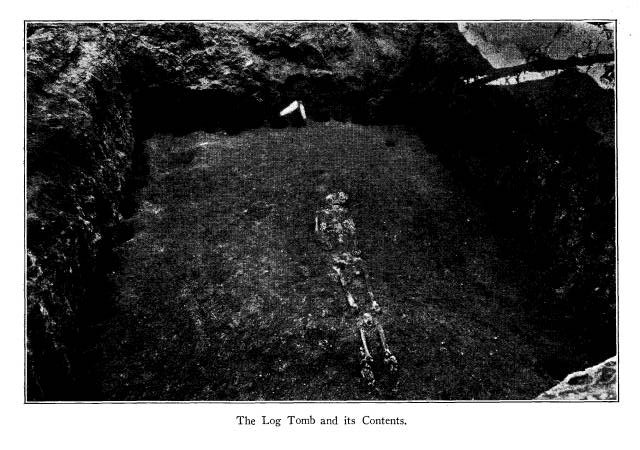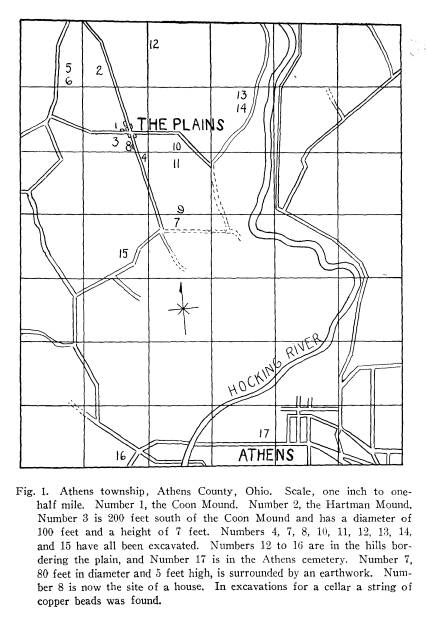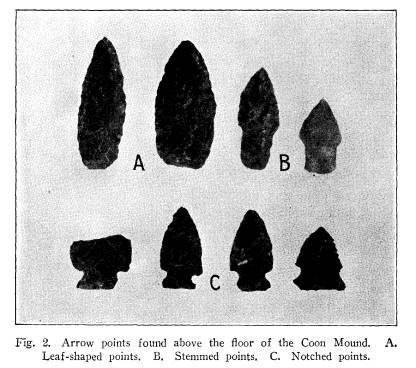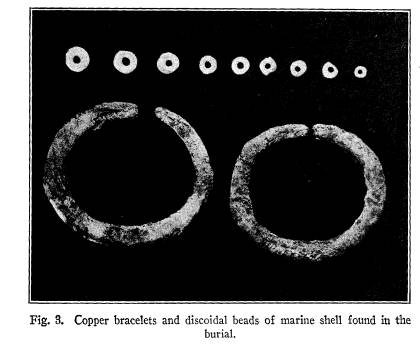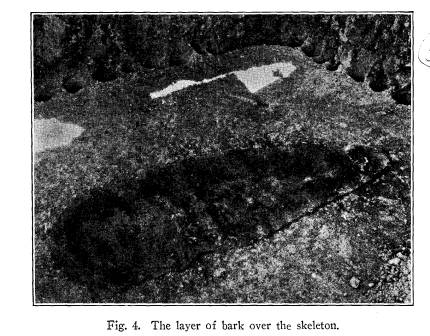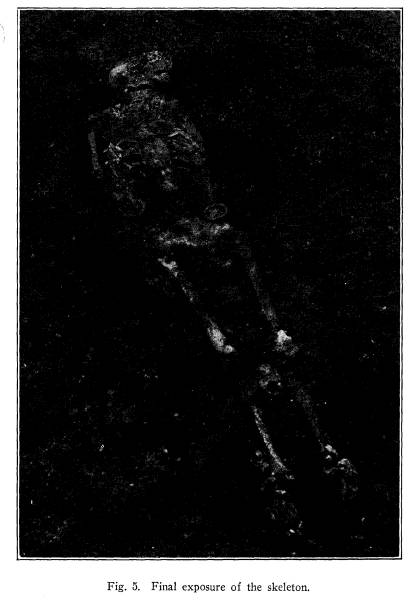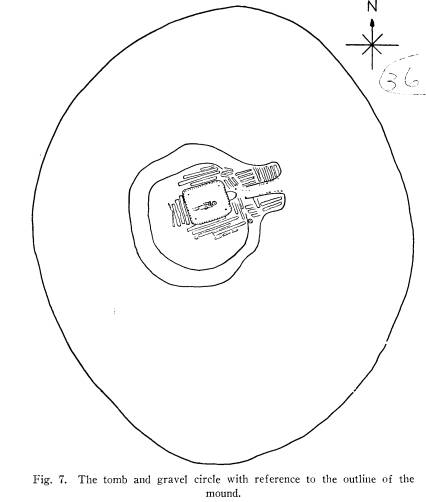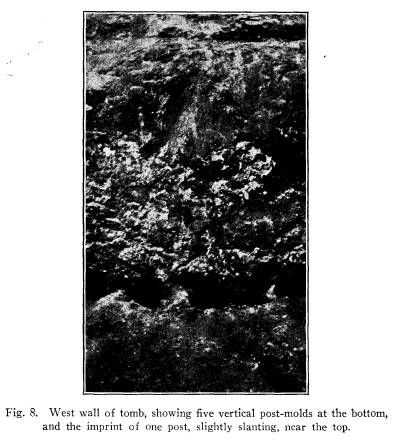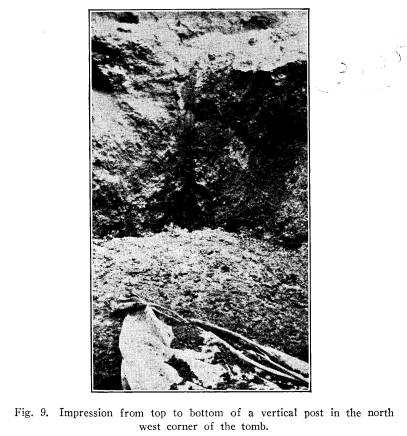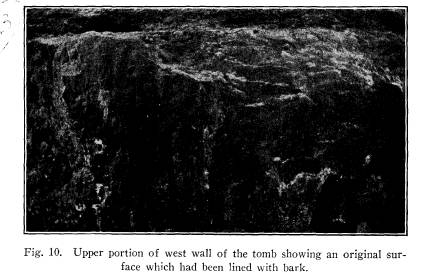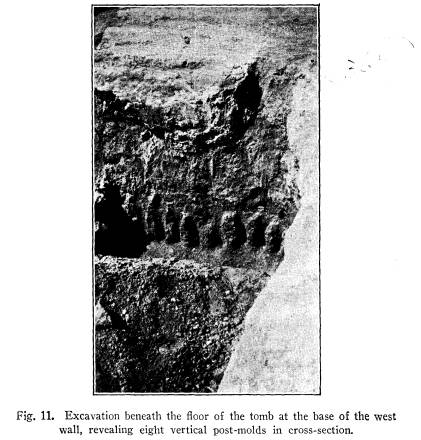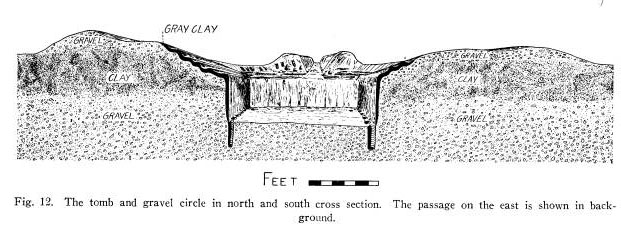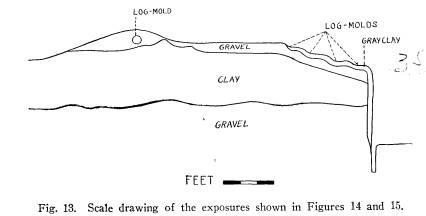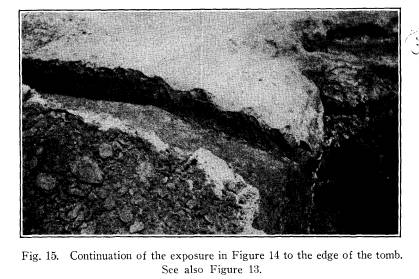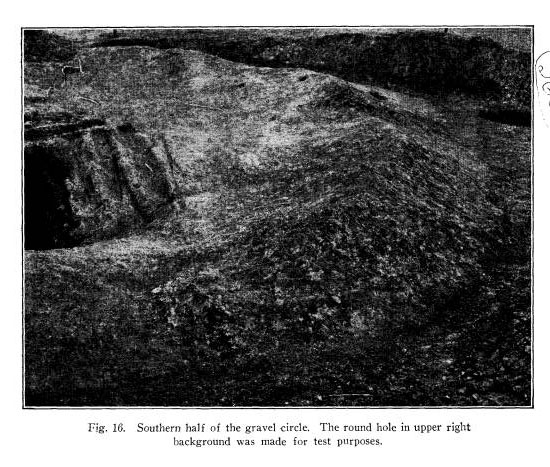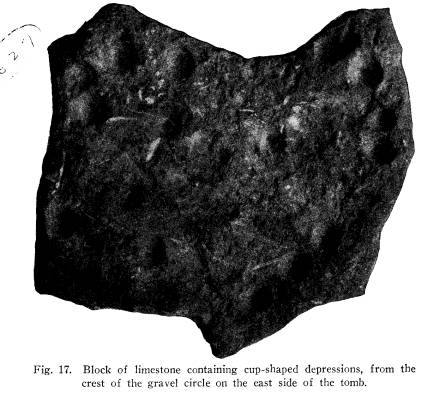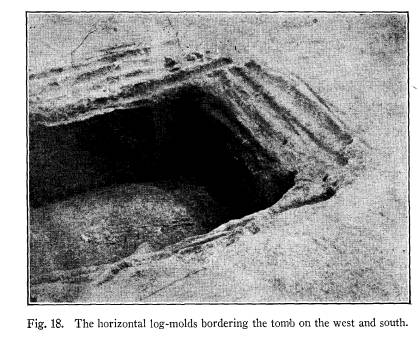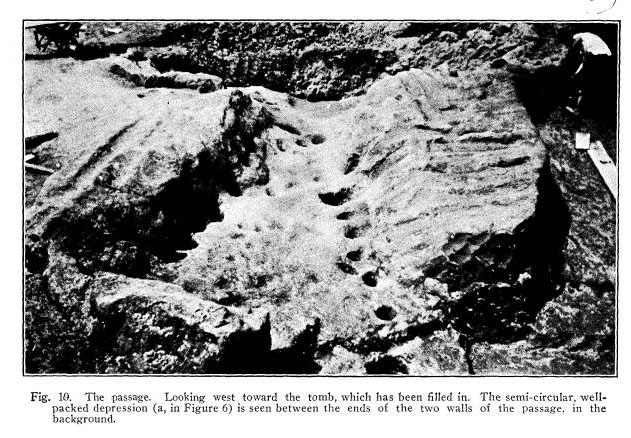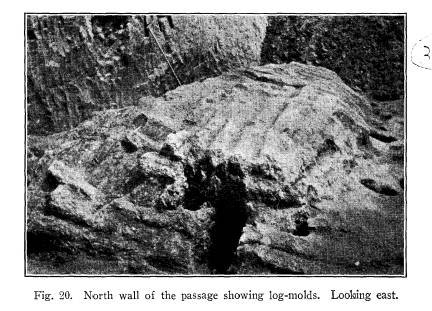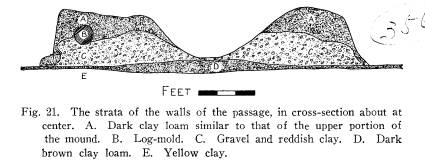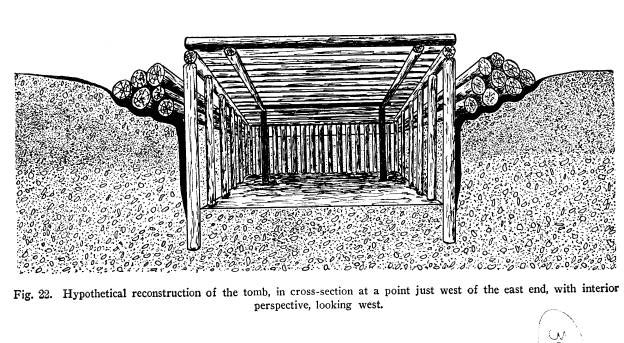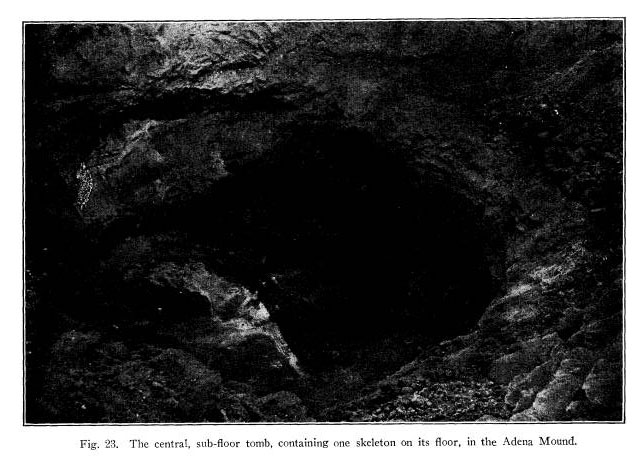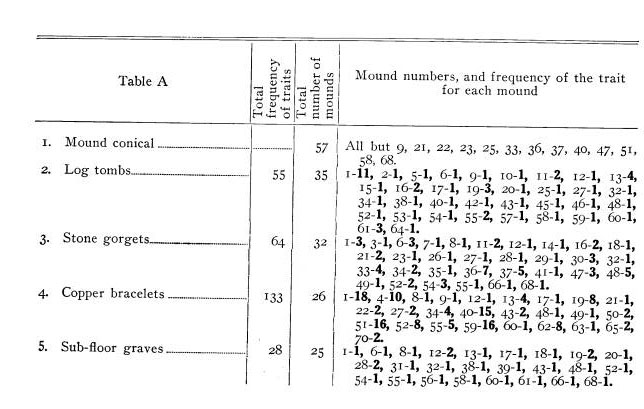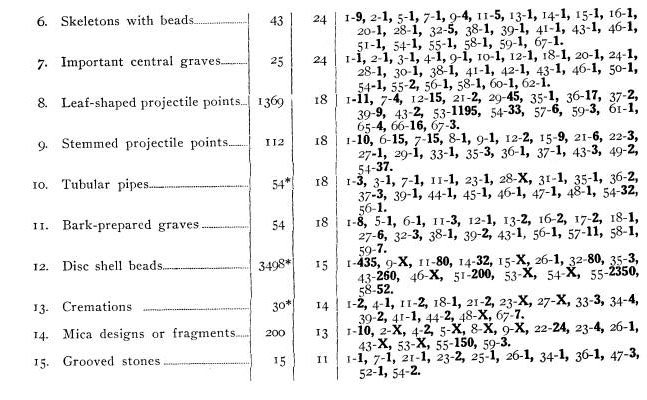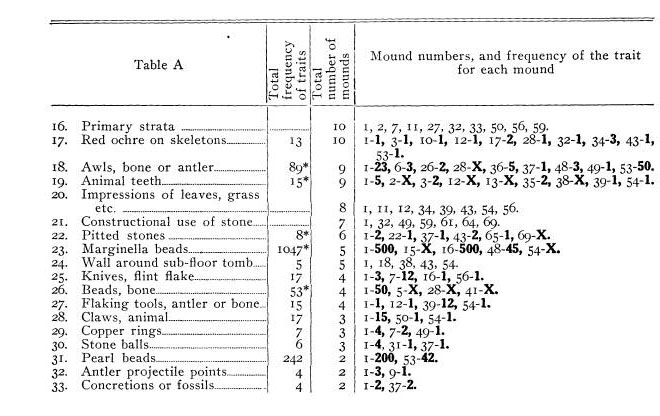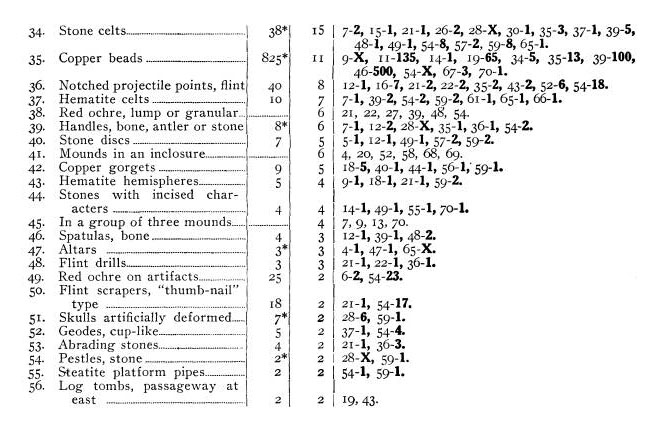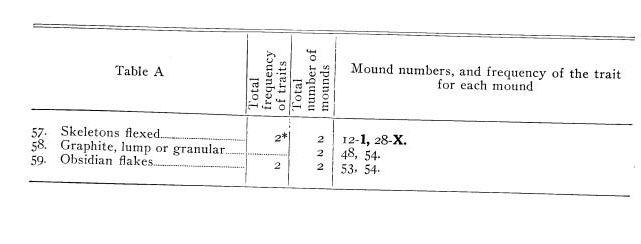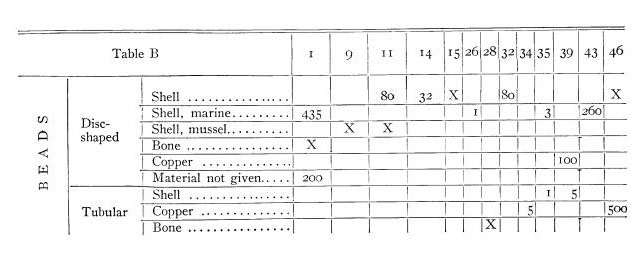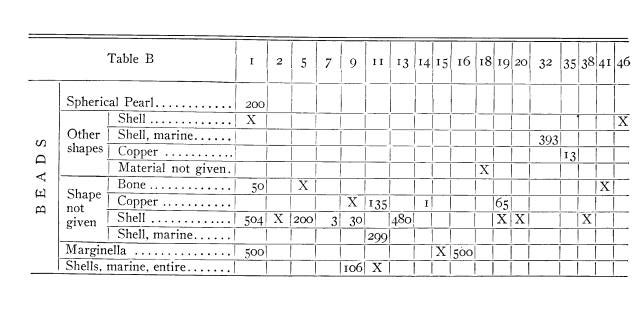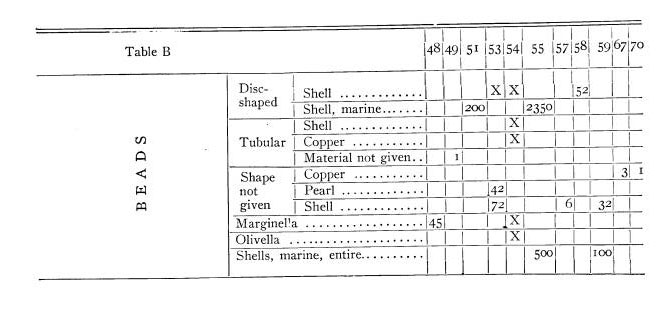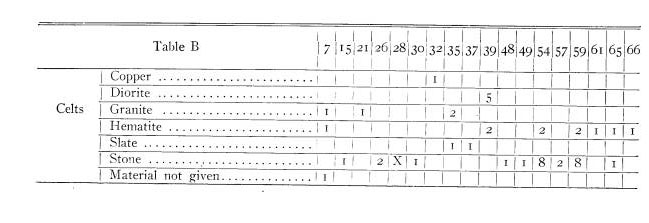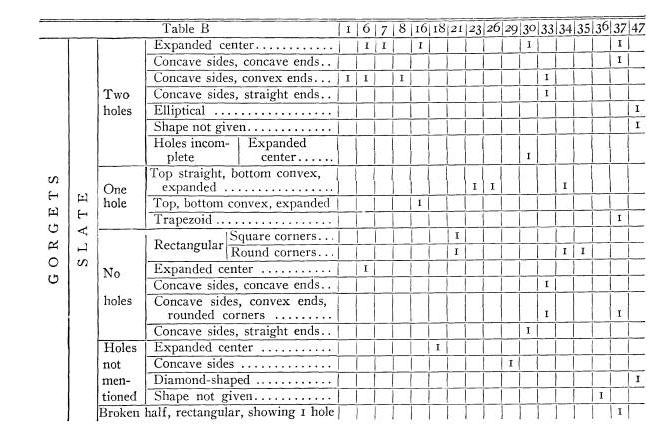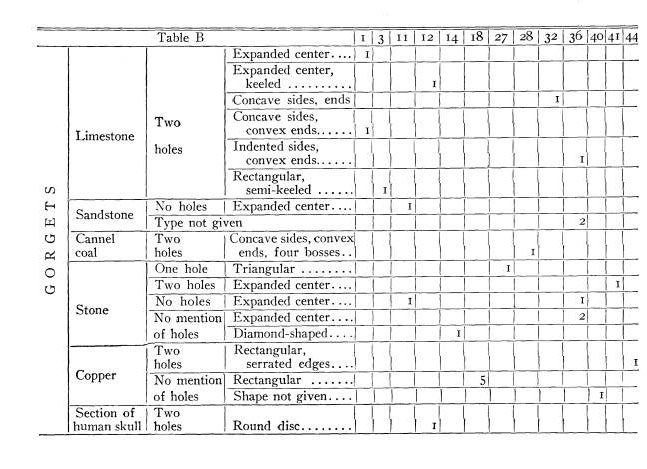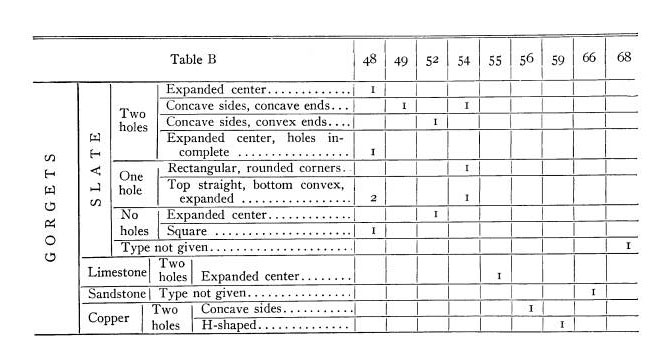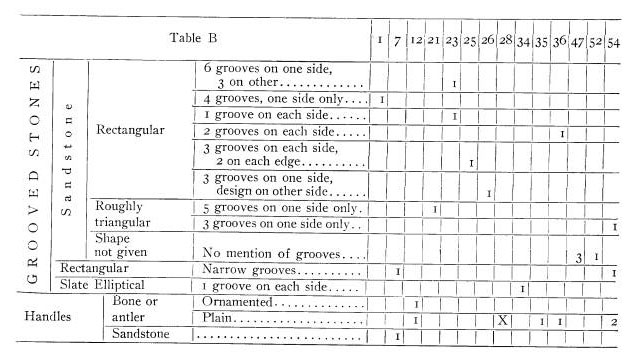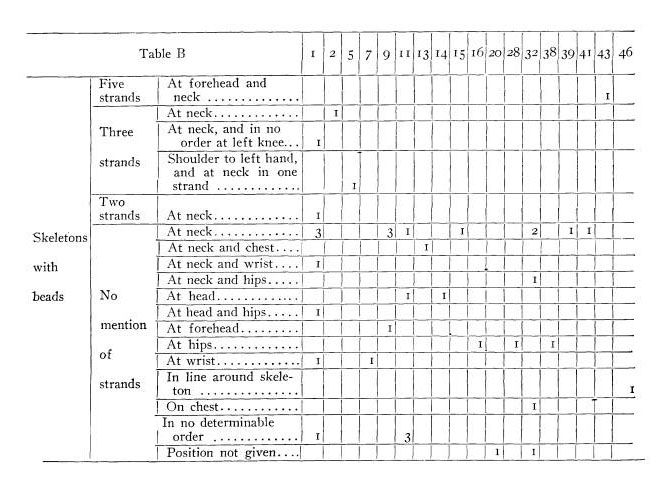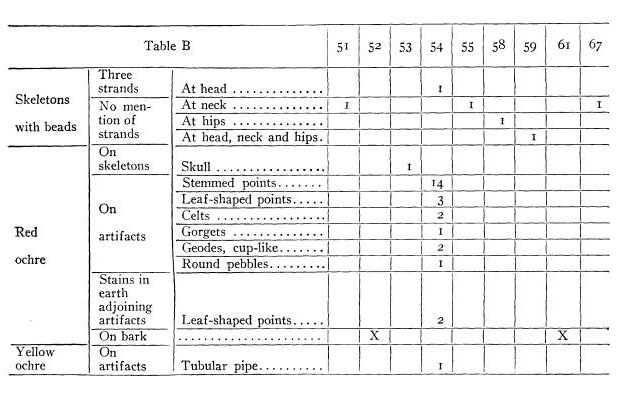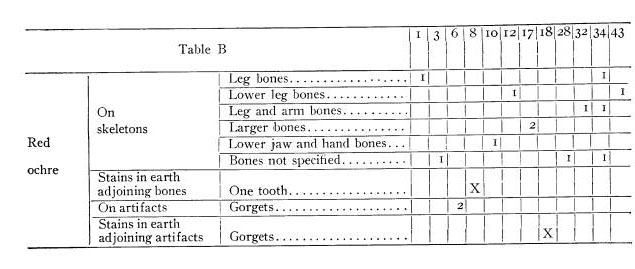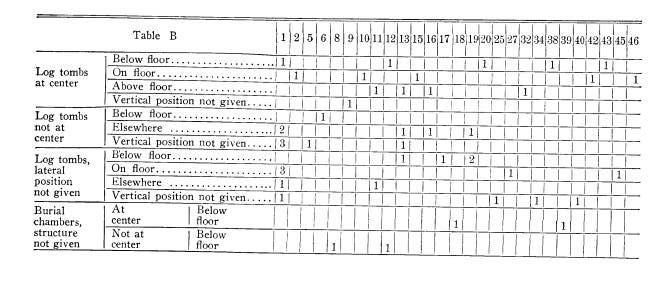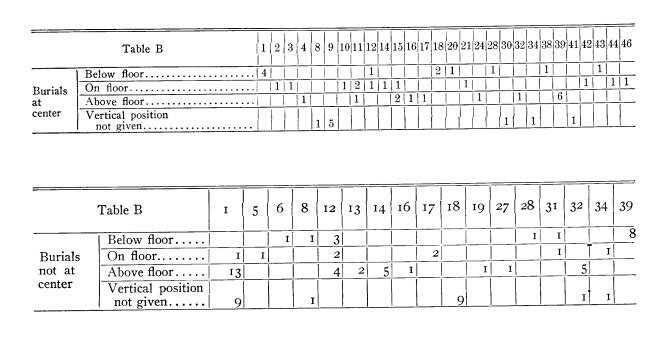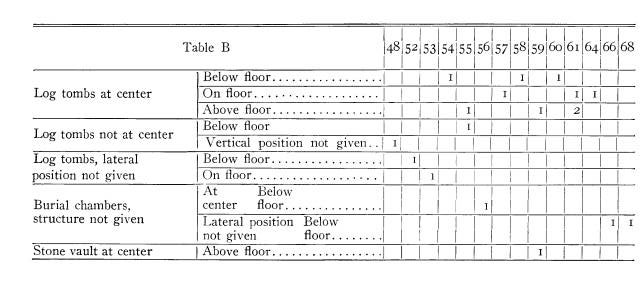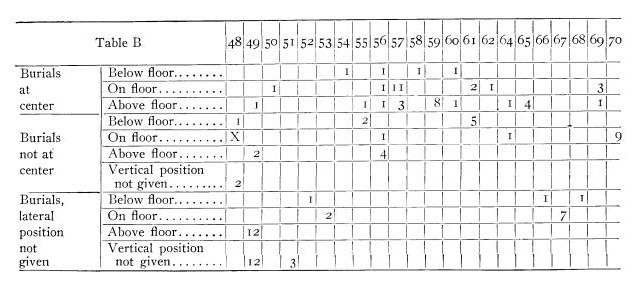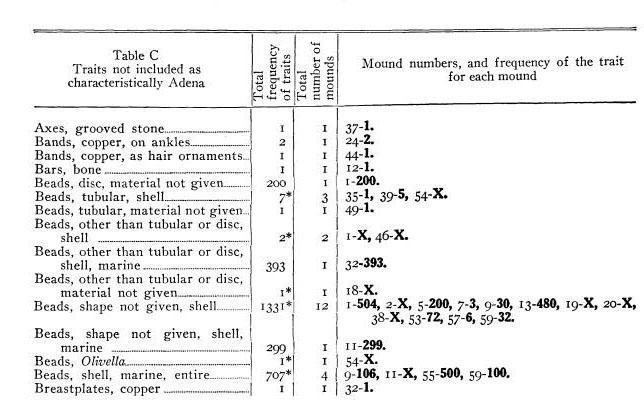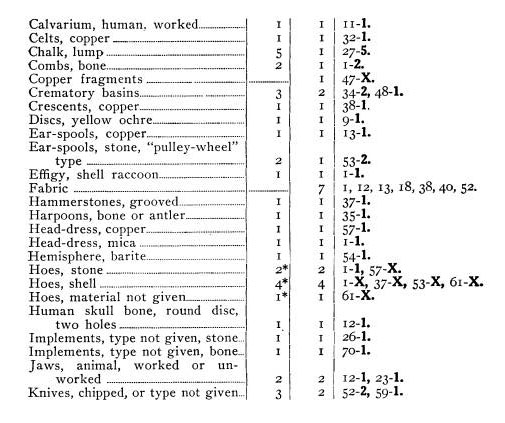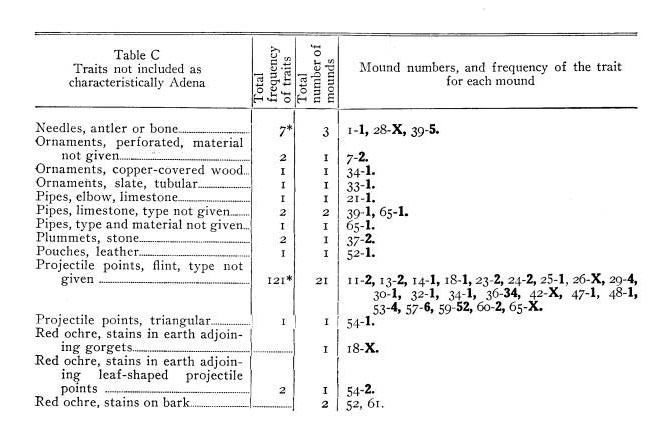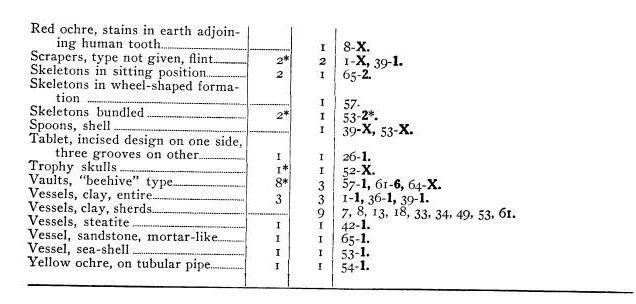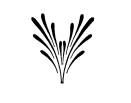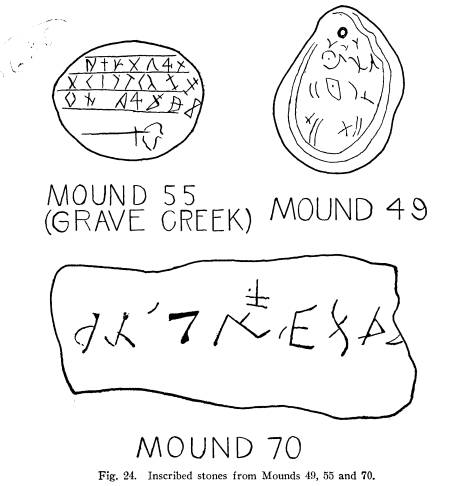Ohio History Journal
|
EXCAVATION OF THE COON MOUND AND AN ANALYSIS OF THE ADENA CULTURE E. F. GREENMAN, CURATOR OF ARCHAEOLOGY |
|
|
EXCAVATION
OF THE COON MOUND AND AN
ANALYSIS
OF THE ADENA CULTURE
TABLE
OF CONTENTS
PAGE
Introductory
Note..................................... 369
General
Features of the Coon Mound ..................... 370
Contents
of the Mound
.............................. .. 375
The Burial....................................... 375
The Tomb
........................................ 379
The Gravel
Circle ................................. 387
The
Horizontal Log-Molds .......................... 392
The
Passage ................................... 397
Reconstruction
................................... 400
Conclusion .........................................
. 408
The
Adena Culture.................................... 411
Introductory Note
....................................... 411
Explanation of
Tables ................................. 414
Table A
............................................. 420
Table B
.............................................. 425
Table C
.................
.......... 442
Table D
............................................. 446
Table E
................................................... 446
Table F .............................................. 447
Discussion of Traits
1 to 59
.............................. 450
Discussion
of Traits Listed in Table C .................... 478
Conclusion ........................................
.. 487
Comparison
of Adena and Hopewell ................. 487
Identity
of the Adena People ....................... 493
Bibliography
........................................ 503
(367)
EXCAVATION OF THE COON MOUND AND AN
ANALYSIS OF THE ADENA CULTURE
E. F. GREENMAN
CURATOR OF ARCHAEOLOGY
INTRODUCTORY NOTE
The Coon Mound receives its name from
Mr.
Gabriel Coon, the owner of the land
upon which the
mound was situated, in The Plains,
Athens County
Ohio. The work of excavation was
accomplished under
the direction of the writer, with the
assistance of Mr.
Robert Goslin.
The mound was at the western edge of
the village,
which is about three and one-half miles
north and slight-
ly west of the city of Athens.
Excavations occupied a
five-week period during July and
August, 1930. The
mound was originally some 25 or 30 feet
in height but
at the time excavations were commenced about
three-
quarters of it had been removed and
spread as top-soil
in neighboring gardens, a process which
had been going
on for many years, beginning apparently
with the level-
ing of the mound about 40 feet in from
the southern
edge to accommodate a section line
road.
In 1930 the mound presented a ragged
appearance.
A semi-circular segment stood up to a
height of about
20 feet on the north and east sides,
and numerous holes
had been dug in the perpendicular face
of this segment,
mostly near its top. Extending westward
from this
face to the edge of the mound, and
southward to the
road, where the material had been
removed to the ground
(369)
370 Ohio Arch. and Hist.
Society Publications
level, there was a table-like elevation
representing the
lowest point to which removal of dirt
for gardens had
reached. The surface of this area was
about six feet
above the ground level, and therefore
about 11 feet
above the bottom of the tomb at the
center. Excava-
tion was begun at the western edge and
continued east-
ward through this remaining base,
presenting a vertical
face only six feet in height until the
semi-circular seg-
ment on the east was reached, where the
face of exca-
vation attained a height of 21 feet.
Fortunately the
tomb and its contiguous structures were
at the center
of the mound and the tearing down of
the mound
previous to 1930 destroyed nothing of
value. Inasmuch
as a great part had been carried away,
no attempt was
made to restore the mound after its
complete excavation.
Excavation was in fact greatly aided,
and the expense
of the operation lessened, by shoveling
the dirt into
trucks in which it was carried away to
enrich the sur-
rounding gardens.
GENERAL FEATURES OF THE COON MOUND
The Coon Mound was one of a number of
mounds
and other earthworks situated on a
level plain in the
northwestern part of Athens County,
west and south
of Hocking River (See Figure 1). This
plain is about
two miles long north and south and a
mile in greatest
width near its center. It is nearly
surrounded by hills
which rise to a height of 200 feet
above the level of
the plain, which is about 65 feet
higher than the valley
flats of Hocking River. On the
northwest and south-
east the two ends of this level area
are gullied by small
|
Coon Mound--Analysis of Adena Culture 371 |
|
|
372 Ohio Arch. and Hist. Society Publications
post-glacial streams where there is a
gradual descent
into the river valley. This topography
is very similar
to that at Chillicothe, where in
prehistoric times a plain
considerably larger was selected for
the site of some
30 or 40 mounds and inclosures.
In the Archaeological Atlas of Ohio
there are re-
corded 25 earthworks and a village site
within a mile
and a half of the village of The
Plains, ten of which were
in the surrounding hills. Eleven of
these are circular
and square inclosures while the rest
are burial mounds.
In a survey of the same general area
during excava-
tion of the Coon Mound only 17 mounds
and one earth-
work were found (Figure 1). Eleven of
these are
on the level plain within
three-quarters of a mile from
the Coon Mound. Half a mile north of
this mound on
the farm of Mr. Gilbert Hartman is the
largest mound
of the entire group (Number 2 in Figure
1), measuring
37 feet in height, with a diameter not
greatly exceeding
that of the Coon Mound. The latter,
second in size,
was identical with the Hartman mound in
general ap-
pearance.
The north and south diameter of the
Coon Mound
was 158 feet; east and west, 132 feet.
These measure-
ments are not in agreement with those
given by An-
drews in Report of Exploration, who
examined the
mound before the year 1876. According
to Andrews the
mound was "about thirty feet high
and with a diameter
of base of one hundred and fourteen
feet." Andrews'
measurement was probaby taken from the
north edge
of the mound to the north border of the
road which
had been cut through the south side of
the mound. This
Coon Mound--Analysis of Adena
Culture 373
distance would be very close to 114
feet. The north and
south diameter secured during
excavation of the mound,
158 feet, was taken from the north edge
to the southern
border of a semi-circular elevation 18
inches in height
immediately south of the road which was
regarded as
the remnant of the southern border of
the mound.
Andrews, examining the face of the
vertical cut
exposed by the road on the south edge
of the mound,
describes a mottled appearance for the
clays, light loam,
gravelly and black earth of which the
mound was com-
posed. This description tallies with
the findings of the
Society's excavations in 1930. No
burials nor struc-
tures of any kind were found above the
floor of the
mound, and all inquiry failed to
disclose that anything
of that nature was found by those who
carried the earth
of the mound away for gardens. The
mottled appear-
ance of the materials of the mound
described by An-
drews is a familiar phenomenon of most
of the larger
burial mounds which have been
excavated. These
patches, varying in color from light
brown or yellow to
black, doubtless represent single
baskets full of earth
deposited by the aboriginal builders.
The material of the upper portion of
the mound was
very rich in organic content and was
unquestionably re-
moved from the surface and to a depth
of from six to
12 inches in the immediate vicinity. No
depressions in
the surrounding surface indicated that
the builders had
gone beneath the hardpan to secure
material for the
mound. The top soil in the vicinity of
the mound is
light in color and somewhat deficient
from the agricul-
tural point of view, quite different
from the earth of
|
374 Ohio Arch. and Hist. Society Publications the mound, which appears to have been gathered to some extent from an occupation site. On the southwest side Andrews found large quantities of "kitchen refuse." This, he reports, was made up of "blackened soil, ashes, charcoal, bits of bone (some burned and some not), |
|
|
|
fresh-water shells, land snails, bits of broken pottery and of broken flints, and small stones, generally burnt, such as might be in fires built on the ground." While the Society's explorations confirm Andrews' estimate of the richness of the soil, very little in the way of "kitchen refuse" was found. The only artifacts found |
|
Coon Mound--Analysis of Adena Culture 375 in the upper portion above the floor were the arrow- points shown in Figure 2. About a dozen fragments of animal bones were encountered in addition to a simi- lar quantity of fragments of calcined human bone. Cer- tainly the amount of refuse material found would not indicate a village site of any great size. |
|
|
|
CONTENTS OF THE MOUND. The Burial. The Coon Mound contained the re- mains of a single individual in a rectangular sub-floor tomb at the center (See Frontispiece). The skeleton was that of a male who at the time of his death was from 25 to 35 years of age. The only artifacts which |
376 Ohio Arch. and Hist. Society Publications
accompanied the skeleton were two
copper bracelets,
one around each wrist, about 260
disc-shaped shell
beads (Figure 3) which had been worn in
five strands
at the forehead and neck, and the clay
object between
the upper ends of the tibiae (See
Figure 5). This ob-
ject, consisting apparently of unbaked
yellow clay, is
four inches long, two inches in width
and thickness. A
hollow interior contains a yellow powder
which adheres
to the sides of the cavity, and a small
quantity of black
clay in spherical lumps about one
thirty-second of an
inch in diameter. Chemical and
mineralogical analysis
revealed a basic sulphate of iron such
as results from
the decomposition of pyrite, a mineral
resembling gold
in its lustre and color. One or more
lumps of pyrite,
very likely mistaken for gold, appear
therefore to have
formed, in the minds of the builders of
the mound, the
main mortuary offering. In the
immediate vicinity of
this mass of disintegrated pyrite the
upper ends of both
tibiae had entirely disappeared (See
Figure 5), a cir-
cumstance which is explained by the
well-known capac-
ity of pyrite for attacking adjacent
materials.
The skeleton was extended on the back,
head to the
east. The arm-bones lay parallel to the
axis of the
skeleton and the right hand lay over
the right side of
the pelvis while the bones of the left
hand lay beneath
the edge of the left side of the
pelvis. The skull, lying
face up, had been badly crushed by the
weight of the
earth. The total length of the
skeleton, measured in
situ, was six feet and two inches, representing a devia-
tion of probably not more than two
inches from the
height of this individual during life.
|
Coon Mound--Analysis of Adena Culture 377 The skeleton lay on the floor of the tomb, ten inches south of the center. The skull was 64 inches from the east wall while the tips of the foot bones were 33 inches from the west wall. It was therefore not in the exact center of the tomb. Beneath the skeleton was a layer of |
|
|
|
bark about half an inch in thickness, which extended out beyond its outline from six to ten inches. Another bark covering, 87 inches long and 30 inches wide, lay directly over the skeleton (Figure 4). This layer varied in thickness from one to three-quarters of an inch. Like the layer of bark beneath, it was reddish brown in some places and black in others. The upper surface of the bark over the skeleton was corrugated, parallel ridges |
|
378 Ohio Arch. and Hist. Society Publications |
|
|
Coon Mound--Analysis of Adena
Culture 379
running north and south in a half-inch
relief and about
twice that distance apart. In addition
to these ridges
there were protuberances corresponding
to bones of the
skeleton directly beneath. At the edges
of the skeleton
the upper and lower layers of bark came
together and
their combined thickness was not at any
point greater
than an inch and a half.
None of the bones of the skeleton were
in a state
of preservation which would permit
accurate measure-
ments. The bones of the feet and legs,
and part of
the right humerus, had retained their
form sufficiently
to stand out above the gravel floor.
These, with the
teeth and fragments of the jaws, were
the only ones re-
moved.
Lying directly on the upper layer of
bark and co-
extensive with it, was a stratum of
firm yellow clay
averaging an inch in thickness. Above
this was the
mixture of black and coarse yellow
earth, the same mate-
rial as that constituting the bulk of the
mound.
The Tomb. The tomb was rectangular with the
long axis running about five degrees
north of east. The
length was 15 feet; width 12 feet and
eight inches
(Figure 6). The depth beneath the
original level of the
ground was about 60 inches, but the southwest
corner
was eight inches lower. The material of
the floor of
the tomb was heavy gravel mixed with
reddish clay.
The surface of the floor was black, a
color due possibly
to the action of fire. This deposit of
mixed gravel and
clay forms a hardpan beginning at a
depth of two to
three feet beneath the surface on the
site of the mound
and for some distance around it.
380
Ohio Arch. and Hist. Society Publications
At the bottom of the vertical walls of
the tomb were
67 holes which were originally occupied
by vertical posts
(Figure 6 and Frontispiece). These
holes varied in
diameter from five to eight inches, and
from center to
center the distance was from six to 23
inches. In depth
beneath the floor of the tomb they
varied from 21 to 27
inches, and at the bottom the holes
were flat instead of
coming to a point. Instead of driving
the original posts
into the floor of the tomb with heavy
stones, the builders
must have dug out a trench about a foot
wide around
the base of the vertical walls, placed
the posts in position
and then filled in around them. The
gravel and clay
beneath the floor of the tomb would
have made it very
difficult if not impossible for them to
dig a hole six inches
in diameter to a depth of two feet
(Figure 11). After
removal of the skeleton excavation was
carried to a
depth of three feet directly beneath it
and the resistance
of the clay and gravel mixture was such
as to necessi-
tate the use of a miner's pick.
The impressions of many of these 67
vertical posts,
particularly of those in the corners,
were traceable in
the clay of the side walls to the top
(Figures 8 and
9). Most of these post-molds in the
walls were vertical,
but a few were at a slant, probably
indicating an acci-
dental deviation due to pressure, from
an original up-
right position.
Inset diagonally about 30 inches from
each corner
of the tomb was a post-mold, of the
same size and depth
as those around the base of the walls.
While the posts
which originally stood in these four
holes probably were
as high as those around the walls of
the tomb, their im-
|
Coon Mound--Analysis of Adena Culture 381 pressions had not been preserved in the soft earth which filled the tomb. |
|
|
|
The walls of the tomb were lined with a coating of gray clay about six inches thick. This coating also |
|
382 Ohio Arch. and Hist. Society Publications underlaid the horizontal log-molds which bordered the tomb on the outside (Figures 12 and 13). Several areas up to a yard in diameter on the vertical walls were very |
|
|
|
smooth, as is shown in Figure 10, while in other areas fine layers of the mottled clay with which the tomb had been filled adhered to the surface of the walls. These smooth surfaces were probably made by the inner sides |
|
Coon Mound--Analysis of Adena Culture 383 of the layers of bark with which the walls were lined, and which were no doubt held in place by the 67 ver- tical posts. No impressions of the outer surfaces of |
|
|
|
bark layers were found on the walls, and the material filling the tomb was too loose and soft to preserve them. The entire surfaces of all four walls however were cov- ered with streaks and patches of red and black, with |
|
384 Ohio Arch. and Hist. Society Publications spots of a white, ash-like substance (Figure 10). The red and white substances were powdery and with small doubt were formed by the disintegration of bark. The black may have been caused by heat. It turned red upon being crumbled between the fingers. In large areas the gray clay of the walls was only half an inch in thick- ness over a layer of yellow clay four or five inches thick. |
|
|
|
In the smooth areas where the original surface of the walls was exposed, the clay was much harder at the surface than an inch or two beneath. This circum- stance, taken together with the presence of the black powder which exhibited a red stain, may be taken as presumptive evidence that a large fire was built in the tomb before the burial was made. In agreement with this the surface of the floor of the tomb was black for the most part, the natural red of the gravel and clay |
|
Coon Mound--Analysis of Adena Culture 385 beneath showing up only in small spots. Of the purpose of this fire, nothing can be said, and if there was a fire, resulting debris such as charred branches was com- pletely cleared from the tomb. |
|
|
|
The earth filling the tomb, similar in consistency and color to that forming the bulk of the mound, was loose and soft. This condition prevailed not only in all parts |
386 Ohio Arch. and Hist. Society Publications
of the tomb itself but for a distance
of three or four
feet above the top of the side walls.
Elsewhere above
the floor of the mound (at the original
level of the
ground) the mottled clay was very solid
and continual
use of mattocks was necessary to break
it up. Mattocks
were not used in removing earth from
the tomb. De-
spite the fact that there had been no
rain for at least
two months prior to these excavations,
the clay of the
lower three feet of the tomb was very
damp, and con-
tinual tramping over the same area
produced a thick
paste. The presence of water may of
course be ex-
plained by pointing out that the inner
slope of the gravel
circle around the tomb (Figures 12 and
16) acted as a
fifty-foot catch basin for all the
descending moisture
in the mound, draining it into the tomb
where it was
brought to a stop by the floor of
gravel and clay. This
moisture may account in some degree for
the softness
of the materials filling the tomb. But
it cannot explain
the looseness of the earth four feet
above the top of the
tomb, nor can it be held responsible
for the existence
of hollow spaces as much as three
inches in diameter
throughout the earth with which the
tomb was filled.
The collapse of a roof of logs,
precipitating the earth
overhead down into the hollow
sepulchre, best accounts
for these conditions. What was left of
this roof, if
our surmise be correct, was found eight
inches above
the floor of the tomb in the form of a
number of log-
molds accompanied by streaks of red and
white powder.
These molds extended the length and
breadth of the
tomb at this level and most of them ran
parallel north
and south while the remainder extended
in all directions
Coon Mound--Analysis of Adena
Culture 387
except the vertical. The soft
honeycombed earth would
not have preserved the mold of a log in
vertical posi-
tion. All that remained of these
roof-logs in the loose
earth were flat streaks of
disintegrated wood that ad-
mitted of no accurate measurement. The
earth around
them filled in their molds as fast as
they decayed. The
six or eight inches of earth between
this stratum of logs
and the floor of the tomb probably sifted
through the
roof before the cave-in.
The Gravel Circle. Beneath that portion of the
mound above the original surface lay
two different kinds
of earth in horizontal strata. At the
floor of the mound
and to a depth of about three feet was
a deposit of
blue-gray clay, somewhat darker at the
top than lower
down. Beneath this was a deposit of
gravel and red-
dish clay of undetermined thickness
(Figure 12). Both
deposits were natural and extended
beyond the site of
the mound.
Those who excavated the tomb utilized
the earth
which they removed to form a raised
circle around it
(Figure 16). This circle averaged two
feet in height
and was continuous except for the
opening on the east
which appears to have been used as an
entrance (Figure
19). The relative positions of the two
different kinds
of earth composing the circle
corresponded to the order
in which they were thrown out of the
tomb. In the
process the blue-gray clay was thrown
out first and
spread around the tomb to form the base
of the earthen
circle. At the bottom of the deposit of
blue-gray clay
the top of the gravel and clay hardpan
was encountered,
and this material was thrown out and
carefully spread
|
388 Ohio Arch. and Hist. Society Publications |
|
Coon Mound--Analysis of Adcna Culture 389 over the base into a symmetrically rounded wall whose crest was from 12 to 15 feet from the edges of the tomb. The inner slope of the wall was rather abrupt for a distance of three feet from the crest, from which point to the edges of the horizontal log molds bordering the tomb the slope was scarcely noticeable. |
|
|
|
The surface of the gravel circle was as smooth as the coarse material of which it was made would permit. Like the surface of the floor of the tomb, but to a lesser extent, it was covered with small and continuous patches of black, giving the whole a mottled red and black ap- pearance. The black may have been the result of fire. The surface of the gravel circle, and to a depth of two inches, was very hard, exceptionally difficult to break up with a pick. Trenches were cut through the circle from one edge to the other at several points, down to the blue- gray clay forming the floor of the mound. One of these trenches, exposing the strata in cross-section, is shown in Figures 14 and 15. In Figure 14 the outer portion of |
|
390 Ohio Arch. and Hist. Society Publications the trench, that exposing the wall proper, is shown. Fig- ure 15 is the continuation of the same trench showing the level part of the gravel circle and the horizontal log- molds (in cross-section) on the incline dipping to the edge of the tomb. Figure 13 is a scale drawing of the entire face of the trench, from the outer edge of the gravel circle to and including the wall of the tomb down to the base of one of the vertical post-molds. The mold of the horizontal log about eight inches beneath the crest |
|
|
|
of the circle (Figures 13 and 14) extended inward from the face of the trench three feet. Similar molds were found in other trenches through the wall of the circle, and in the north wall of the passageway (Figure 21). Aside from the possibility of a ceremonial function these logs, perhaps left over after the timber construction in |
|
Coon Mound--Analysis of Adena Culture 391 the tomb was finished, may have been used simply as filling. The surface of the floor of the mound directly be- neath the gravel circle contained impressions, and often the disintegrated remains, of leaves, twigs and grasses in profusion. Among these impressions were occasional very small flakes of mica not more than an eighth of an |
|
|
|
inch across. Beyond the edge of the gravel circle the surface of the floor was almost entirely devoid of such materials. The floor itself had no well-packed stratum of muck such as is usually found in mounds of the Hope- well type, and represented merely the original surface of the ground before the mound was erected, unmodified except perhaps for some levelling; apparently however it had been swept clear of the debris of the forest while beneath the gravel circle this debris remained untouched. |
392
Ohio Arch. and Hist. Society Publications
Aside from the possibility of a
ceremonial purpose, two
possibilities explain this situation.
The twigs, grasses,
leaves and so forth, cleared from the
floor of the mound,
were deposited in the area to be
covered by the gravel
circle as the easiest way in which this
material could
be disposed of; or the debris on the
floor beyond the
borders of the gravel circle was swept
toward the out-
side of the area to be occupied by the
mound, that on
the site of the gravel circle being
left in place because
it was to be covered up. Of course the
ceremonial ex-
planation offers a third possibility,
its plausibility being
somewhat heightened by the presence of
small flakes of
mica, which were not found elsewhere in
the mound.
A large square block of limestone
containing 16
pits, shown in Figure 17, lay upon the
crest of the
gravel circle east of the tomb near the
point where the
end of the circle expanded into the
south wall of the
passage (Figure 6). This stone is 16 by
12 inches, and
eight inches thick. The side opposite
that in the illus-
tration is very uneven. Pieces of
another stone, the
largest fragment containing three pits,
lay in one of
the parallel horizontal log-molds to the
south of the
southwest corner of the tomb (See
Figure 6).
The Horizontal Log-molds. The
impressions of
horizontal logs paralleled each of the
four sides of the
tomb (Figures 6, 13, 15, 18). On the
north there were
four of these impressions, only two of
which extended
the length of the tomb. These two
log-molds were
about a foot wide and from six to eight
inches deep.
Four log-molds of similar dimensions
paralleled the
southern wall of the tomb; there were
three on the west,
|
Coon Mound--Analysis of Adena Culture 393 |
|
394 Ohio Arch. and Hist. Society Publications with the molds of two crossed poles adjacent to the outer log-mold. On the east there were two log-molds about 20 feet in length and eight inches in width, the original timbers of which extended either under or over a rounded depression at the edge of the tomb (a, in Figure |
|
|
|
6), or it is possible that the two logs terminated at the sides of this depression. To the east of this depression were the molds of other shorter logs, extending to the base of the west end of the passageway (Figure 20). These horizontal log-molds were in an inclined position, |
|
Coon Mound--Analysis of Adena Culture 395 the slope beginning at the inner edge of the level por- tion of the gravel circle and extending to the tops of the perpendicular walls of the tomb, which were about 18 inches beneath the floor of the mound. Thus at a certain stage in its construction the tomb presented the appearance of a square funnel-shaped depression with |
|
|
|
rounded corners, the lower three feet of whose sides were perpendicular. Later about a foot of the slanting sides of this funnel were overlaid with the gravel thrown out from the tomb proper, this gravel forming a down- ward extension of the gravel constituting the circular wall. Next, the perpendicular sides of the tomb and the slanting sides of the funnel were overlaid with a coating |
|
396 Ohio Arch. and Hist. Society Publications |
|
Coon Mound--Analysis of Adena Culture 397 of gray clay about six inches thick. Upon this coating were laid the horizontal logs along the slanting sides from the inner edges of the wall to the tops of the perpendicular sides of the tomb (Figure 12). In some of these horizontal log-molds there were holes an inch or two in diameter and about a foot in depth, left by vertical stakes. Layers of white powdery, ash-like re- |
|
|
|
mains of the disintegrated logs, of varying thicknesses up to a quarter of an inch, were distributed in irregular streaks and patches in and between the log-molds. The Passage. On the east the two ends of the gravel circle turned abruptly eastward to form the par- allel walls of a narrow corridor 12 to 15 feet in length and about four feet wide at the floor level (Figures 6, |
398
Ohio Arch. and Hist. Society Publications
19). This corridor had all the
appearance of a pass-
ageway through which the tomb was
approached and
entered.
The two walls stood up from the floor
of the mound
from three to four feet; that is, the
topmost horizontal
log-molds found upon them were at this
level. In Fig-
ure 21 the strata of the two walls
about at the center are
shown in transverse cross-section. The
gravel base of
these walls (C in Figure 21) is continuous
with the
gravel of the circle around the tomb,
descending to the
floor-level at the east ends of the
walls. Overlying the
gravel of each wall to a height of a
foot and a half
above it were mottled blue, gray and
yellow clays, re-
sembling closely the materials in the
body of the mound.
On the flat tops of the walls, five or
six feet in width,
were numerous log-molds from six inches
to a foot or
more in width, lying in parallel
horizontal rows in
groups at right angles to one another
(Figures 19, 20).
Some of the log molds disposed at right
angles to the
length of the walls extended down the
sloping inner
sides into round depressions four or
five inches in depth
(Figure 19).
The floor of this passageway, at the
general level of
the floor of the mound, consisted of
gravel and clay
similar to that making up the base of
the two walls, as
is shown in Figure 21. Like the floor
of the tomb,
the surface of this gravel and clay was
very hard
and covered with irregular patches of
black. The top
of the underlying stratum of dark clay
(D in Figure 21)
contained the imprint of grasses,
leaves, twigs and so
forth. Lying above the gravel floor was
a deposit of
|
Coon Mound--Analysis of Adena Culture 399 gray clay from one to six inches thick, containing the impressions of the ends of posts or logs, resembling post-molds in appearance, along both sides of the pass- ageway at the bottoms of the interior slopes of the two walls (Figure 19). Some of these round depressions reached to the surface of the gravel floor while others did not. Many of them were not more than an inch or two in depth. This layer of gray clay above the gravel floor was no more solid in texture than the mottled clay directly above, forming the upper part of the mound |
|
|
|
proper, and it bore no signs of fire. The semi-oval area between the west end of the passageway and the east wall of the tomb (this is shown in the background in Figure 19, and on the floor-plan in Figure 6) was very firm in texture on the surface and for two inches be- neath, as if the clay had been packed solid by the pres- sure of many feet. Such pressure would have left no noticeable sign on the surface of the almost brick-hard gravel and clay floor of the passageway, upon which those who passed between the two walls probably walked. The inner edges of the two walls of the passageway |
400
Ohio. Arch. and Hist. Society Publications
were not parallel throughout their
entire length, as a
glance at Figures 6 and 19 will show.
For a distance
of six and one-half feet from the west
end the corridor
is from 36 to 40 inches in width,
widening eastward
from that point to form an outer
opening about seven
feet wide. Three and one-half feet
above the floor a
single log-mold extended northeast from
the end of the
south wall, apparently turning the
entrance of the cor-
ridor to the north. This log-mold,
shown in the fore-
ground in Figure 19, rested upon dark
clay similar to
that forming the upper stratum of the
walls of the corri-
dor, but the clay in this instance did
not rest upon the
gravel, which terminated at the ends of
the two walls.
The mold was poorly defined and
isolated by two feet
from the end of the south wall. For
this reason it was
not included in the floor-plan in
Figure 6.
Reconstruction. The
condition of the tomb and its
contiguous structures as they were
revealed by excava-
tion have now been described in detail
and it is obvious
that the picture obtained so far
represents but a momen-
tary condition in time and space. With
a difference of
five hundred years in either direction
the picture would
have been quite another one; backward,
more complete,
forward, more fragmentary. The picture
obtained in
1930 was made by following out the
various strata, and
differentiating between them on the
basis of their rela-
tive hardness, color and consistency.
This picture deals
mostly with flat impressions and
cavities of objects
which once were solid and
three-dimensional, and which
in some instances formerly occupied
different positions
from those in which their molds were
finally uncovered.
|
Coon Mound--Analysis of Adena Culture 401 |
402
Ohio Arch. and Hist. Society Publications
Our picture is but a rough outline
drawing of certain
portions of an original structure of logs and bark which
was covered with earth. The missing
portions may be
sketched into the picture by
interpretation of strata, by
inferences based upon our own knowledge
of construc-
tion in wood and by consideration of
the purposes and
aims of the builders of this burial
mound. In this re-
construction an attempt will be made to
show that the
tomb and the passageway were roofed,
and to explain
the function of the timbers which
originally occupied
the horizontal log-molds around the
tomb. Interpreta-
tion must be made with two
considerations in mind.
First, this subterranean structure was
built to receive
the remains of the dead, and many of
its features sym-
bolized to the builders certain of
their religious or magi-
cal beliefs bearing upon the phenomenon
of death. The
more apparent of these symbolical
aspects of the tomb
and its parts are its orientation
approximately with the
cardinal points, the situation of the
passageway on the
east and the position of the skull of
the burial to the
same direction, the gravel circle
enclosing the tomb and,
perhaps, the fact that it was beneath
the original level of
the ground, for this structure could
have been erected on
the surface and still have been
subterranean, some fifteen
or twenty feet beneath the top of the
mound. While it
is easy and attractive to give a
utilitarian interpretation
to the various logs and posts which
left their unmistaka-
ble impressions, some of these
features, for example the
horizontal logs on the four sides, may
have been so
placed entirely for symbolical or
ceremonial reasons. In
fact it is entirely possible that every
post, log and layer
Coon Mound--Analysis of Adena
Culture 403
of bark which served a practical
purpose in the construc-
tion of the tomb symbolized at the same
time some as-
pect of those special procedures which
primitive people
build up around the phenomenon of
death.
Second, if our assumption of a roof is
correct, the
builders found themselves confronted
with problems of
a highly practical nature. The
positions of some of the
timbers at least were determined by
utilitarian consid-
erations. The roof must be supported and
some pro-
vision was necessary against lateral
pressure of the
earth of the mound against the sides of
the tomb if they
projected above the floor of the mound.
Correct recon-
struction of the tomb therefore depends
upon the ex-
pertness of the builders in solving
these problems. A
faulty solution on their part would
result in the placing
of timbers in positions which would
prohibit a reasona-
ble utilitarian interpretation. In
reconstructing the orig-
inal appearance of the tomb it
therefore becomes in-
creasingly difficult for us to
distinguish between the
utilitarian and the symbolical, and the
reconstruction in
Figure 22 is admittedly hypothetical.
The following features strongly suggest
that the
tomb was originally roofed: the four
inset post-molds in
the floor, the looseness of the earth
within and above
the tomb, and the presence of
disintegrated timbers eight
inches above the floor. The structure
and purpose of
the tomb may be taken as further
evidence. Keeping
strictly within the limits of the known
facts, the sym-
metry of the tomb and the vertical
post-molds in the
floor indicate a comparatively
complicated architectural
structure and without much doubt the
dwelling-houses
404
Ohio Arch. and Hist. Society Publications
of the builders offered the plan and
pattern for this
house of the dead. Presumably their
houses were roofed
and if the tomb and the entrance
faithfully reproduce
their features they also were covered
in some manner.
The practice of contructing the
sepulchre upon the plan
of the dwelling house is not unknown
among prehistoric
peoples. Dwelling houses have been
reconstructed from
wooden grave chambers in Europe, belonging
to the
Hallstatt Period of the Iron Age, and
small clay urns,
receptacles for the ashes of the dead,
were modelled in
imitation of the dwelling huts of the
time (See Prehis-
toric Ancestors, pp. 291, 296).
It is not necessary to suppose that the
entire mound
and the tomb were erected during one
continuous period.
It is entirely possible that a
considerable interval of
time elapsed between the completion of
the tomb and the
erection of the mound above and around
it; that, in
other words, the interior of the tomb
remained accessible
from the outside, through the
passageway on the east,
during a period of mourning. It is
equally possible
that the passageway, roofed and sided
with timbers, re-
mained open after completion of the mound,
or at least
that such was the intention of the
builders. A roof over
the tomb could have served one or both
of two purposes;
to protect the interment from the
elements during the
period of mourning before the mound was
thrown up,
and to protect the interment and
whatever perishable
objects may have accompanied it from
the weight of the
earth after erection of the mound.
There is no way to
estimate the time occupied in throwing
the earth over
the tomb to a height of thirty feet.
But with the ac-
Coon Mound--Analysis of Adena
Culture 405
cumulation of weight upon the roof it
may have col-
lapsed, and if so those engaged in the
work were proba-
bly aware of it.
Several equally plausible
reconstructions of the eleva-
tion of the tomb could be made, but the
available evidence
points to a structure resembling that
in Figure 22. This
drawing is made from the point of view
of an observer
standing at the east end of a vertical
cut revealing the
interior of the tomb in cross-section.
The vertical posts
lining the walls of the tomb were not
more than two
feet apart. In the drawing they are
represented at a
greater distance from one another as an
aid to the
graphic presentation of the structure
of the tomb in its
relationship to the surrounding
horizontal timbers at the
original level of the ground. In this
reconstruction the
known facts have admittedly been
transcended, in an
effort to explain the circumstances in
the light of our
own knowledge of the stresses and
strains involved in
the construction of underground wooden
chambers.
The roof is placed at a distance of
three or four feet
above the tops of the side walls, or
eight or nine feet
above the floor of the tomb. This
position has been de-
termined in relation to the attempt to
explain the mean-
ing of the horizontal log-molds as the
remains of logs
which had a mechanical significance in
the structure of
the tomb. Further, this interpretation
leaves a clearance
or three or four feet at the east end
for entrance into the
tomb proper from the passageway. The
height of the 67
vertical post-molds outlining the floor
of the tomb, which
with the four inset post-molds
represent the remains of
uprights supporting the roof, could not
be determined.
406
Ohio Arch. and Hist. Society Publications
The 67 side-posts certainly extended to
the tops of the
tomb walls, leaving their impressions
in some instances
from top to bottom (Figure 9). Streaks
of disinte-
grated wood which may have been the
tops of these ver-
tical posts were found at a distance of
three or four feet
above the walls of the tomb in the
soft, honeycombed
earth of that area, but they could not
be traced to the
impressions in the side walls with any
certainty. It
should be noted that a cave-in would
completely destroy
the alignment of vertical post-molds.
In figure 22 the horizontal log-molds
have been in-
terpreted as the bases of piles of
logs, the purposes of
which were to absorb the weight of the
earth around the
sides of the tomb, a function which
they would serve
efficiently only by being piled
pyramidally, without touch-
ing the upright posts supporting the
roof; the earth oc-
cupying the intervening space being
prevented from fall-
ing through the cracks between the
upright posts by
extension of the bark lining of the
wall to the roof.
Small stake-holes in the edges of some
of these hori-
zontal log-molds apparently represent
an attempt to hold
the piles of logs in place and to keep their
weight, in-
creased by the lateral pressure of the
earth of the mound,
from crushing the side-walls. It is
possible that the
inner logs of the horizontal piles were
placed close
against the upright posts to a height
equal to that of the
roof. The pressure of these logs would
have been con-
siderable however, probably as great as
the earth would
have exerted had there been no
horizontal timbers in
these positions.
The bottom logs of these horizontal,
pyramided
Coon Mound--Analysis of Adena
Culture 407
piles, rest upon an incline. A glance
at Figure 12 will
show that this incline starts above the
original ground
level, on the inner slope of the gravel
wall, and descends
to a depth of from one to two feet
beneath the original
ground level, at which point is the
vertical drop of the
side walls. The structural significance
of this incline
might be regarded as a further attempt
to lessen the
weight of the earth against the vertical
posts, an attempt
however, which was not effectual.
The three girders upon which the
timbers of the roof
are supported are shown resting on the
tops of the ver-
tical posts. There was of course
nothing to show the
manner in which these girders were fastened
to the tops
of the posts. The latter, including the
four inset posts,
may have been forked at the top, and
the girders tied in
firmly with thongs.
The log-molds on the walls of the
passageway are
easier to interpret. There is strong
evidence here of
a cave-in, as in the tomb, but the lack
of vertical post-
molds of any depth in the floor of the
passageway points
to simplicity in construction.
Apparently this corridor
had a roof of logs and bark, the ends
of the logs resting
upon the tops of the two walls, giving
a height to the
passageway of only three feet. The
depressions at the
bases of the walls and the log-molds
down the slopes of
their inner sides may be explained by
supposing that
when the cave-in occurred the logs of
the roof were
broken at center, and at the inner
edges of the tops of
the walls. The pressure of the earth
forced the ends of
the logs at the broken center, down
upon the gravel floor,
leaving their round, more or less
vertical impressions at
the sides of the walls (Figure 19).
408
Ohio Arch. and Hist. Society Publications
CONCLUSION
The Coon Mound exhibits the
characteristic features
of the Adena culture in its purest
form. This culture is
described in the final chapter of this
report, and a brief
enumeration of the main elements will
suffice for the
present purpose. These are as follows:
conical mounds,
sub-floor burial as well as burial in
the upper part of
mounds, sepulchres of various sizes
built of logs, use of
copper mainly for ornamental rather
than for practical
purposes, certain types of slate or
limestone gorgets, to-
bacco pipes of the simple tubular type,
and flint points
of the unnotched leaf-shaped, and the
square-stemmed
types. The name of this culture is
taken from the Adena
Mound, in Chillicothe, Ross County,
which was exca-
vated by the Society in 1901. Nearly
all of the features
exhibited by the Coon Mound were found
also in the
Adena Mound. The sub-floor tombs at the
center of
both mounds were of approximately the
same size, and
both were rectangular; each contained
on its floor a
skeleton extended at full length, whose
lower leg bones
were painted with red ochre (See Figure
23). In
the Adena Mound the clay and gravel
from the tomb
had been used in forming a wall at the
ground level
which, in the cross-section shown in
Excavations of the
Adena Mound in Figure 19, was of about
the same size
and contour as that of the wall in the
Coon Mound.
While extreme caution is necessary in
making deduc-
tions regarding social status from the
manner in which
the dead are buried, it seems worth
while in the present
instance to suggest that the individual
entombed in the
Coon Mound was a person of considerable
importance.
|
Coon Mound--Analysis of Adena Culture 409 |
410
Ohio Arch. and Hist. Society Publications
The erection of a mound of this size
over the remains
of a single individual is very
suggestive and the presence
of red pigment on the tibia of the
skeleton is of further
significance. Captain Romans, who
travelled among the
Indians of the south before 1775, makes
the following
statement in regard to the burial
customs of the
Choctaw:
"As soon as the deceased is
departed, a stage is erected, and
the corpse is laid on it and covered
with a bear skin; if he be a
man of note, it is decorated, and the
poles painted red with
vermillion and bears oil . . . the head
being painted with ver-
million (after the flesh has been
scraped off) is with the rest
of the bones put into a neatly made
chest . . ." (A Con-
cise History of Florida, p. 88).
A number of other Adena type mounds
have con-
tained skeletons, parts of which were
painted with red
ochre. These include the Westenhaver
Mound and the
Fortney Mound, both excavated for the
Society, and a
mound in Illinois, numbered 53 in the
following study
of the Adena culture. In the latter
mound the red ochre
was on the skull only.
Taking into consideration the facts
that the Coon
Mound contained the remains of only one
individual, and
that an elaborately constructed tomb
was covered with
thirty feet of earth, the conclusion
that the individual
represented was a leader of some kind
among his people
is probably not far from the truth.
In age, the Coon Mound was prehistoric,
like all
mounds of the Adena type so far
excavated. Despite
certain contrasts with the Adena and
other mounds of
the same culture, nothing was found to
provide a basis
for conclusions as to their relative
age.
THE ADENA CULTURE
INTRODUCTORY NOTE
In the following study, sixty mounds
are classed as
Adena in type which have not heretofore
been included
in that culture. In this process the
zoological method of
identifying a species is used as far as
it is possible to do
so. According to that method of
classification and de-
scription the first specimen of the
type to be found and
described is the type specimen. While
the Grave Creek
Mound, number 55 herein, was partially
excavated in
1838, the Adena Mound, Number 1, was
the first one
belonging to the culture-type to be
completely excavated
and described, and it is therefore the
type specimen, a
fact already recognized by Shetrone in
Culture Problem
in Ohio (page 161). The inclusion of
other mounds un-
der the specific term Adena is
made herein upon the basis
of the characteristics exhibited by the
Adena Mound.
Shetrone has recognized five mounds as
Adena in
type in the paper just referred to.
These are the Adena,
Westenhaver, Grave Creek, Miamisburg
and Great
Smith mounds; the latter is number 58
in the present re-
port, and belongs to the Kanawha Valley
Group in West
Virginia. In addition the same
authority includes other
mounds of the Kanawha Valley, and of
the Scioto Val-
ley in Ohio, and since their excavation
the material from
Mounds 16, 29-32 and 35 has been on
exhibit in the
Museum of the Ohio State Archaeological
and His-
torical Society as Adena in type.
(411)
412 Ohio Arch. and Hist. Society Publications
The distinctive traits of Adena culture
have been
listed by Shetrone (Op. cit., page 160)
as follows:
"Shapely, conical mounds, generally
single but sometimes oc-
curring in apparent series; mounds
unaccompanied by earth-
works; absence of pre-structures of
upright timbers, sites of
mounds unlevelled and showing no
evidence of previous use;
erection of mounds often begun by piling
logs and brush upon
the sites or bases; non-cremation of the
dead; burial made
upon the base line and throughout the
mounds, usually with an
important central grave below the base
line; sepulchres of logs
often used, particularly for the more
important burials. Materials
from distant sources, as with the
Hopewell culture proper, were
extensively used, but copper appears to
have been employed for
objects of ornamentation only, and
rarely if ever for utility im-
plements. Of the artifacts persistently
occurring there may be
mentioned copper bracelets and finger
rings; gorgets of the ex-
panded center and concave edge type;
tubular pipes; necklaces
of beads made from univalve shells; and
projectile points of flint
of the ovate unnotched and the stemmed
type."
This general statement is verified in
the following
tables, with the exception of cremation
and the occur-
rence of mounds within inclosures.
Thirty of the 350
or more burials in the seventy mounds
under discussion
were cremated, and six of these seventy
mounds were
either at the center or in a gateway of
an inclosure.
In the following tables the contents of
seventy
mounds, distributed in Ohio, Indiana,
Illinois, West
Virginia, Pennsylvania and Tennessee
are listed. Be-
ginning with the Adena Mound in Chillicothe,
Ohio, each
mound is numbered serially in
geographic progression.
There is a break between Mounds 47 and
48, since the
first 47 mounds are in Ohio and Mounds
48 to 52 are in
Indiana. Mound 53 is in Illinois, from
where the series
jumps again, to West Virginia,
beginning with Mound
54 and ending with Mound 69. Mound 56
is in Penn-
Coon Mound--Analysis of Adena
Culture 413
sylvania but is included in the West
Virginia series be-
cause of its proximity to Mounds 54 and
55. Mound 70
is in Tennessee.
While there is little question that the
Miamisburg
Mound, in Montgomery County, the
highest mound in
Ohio, is Adena in type, it has not been
included among
the seventy listed herein. Excavation
of a central shaft
in this mound in 1869 is reported in
Volume XIV of
the Publications of the Ohio State
Archaeological and
Historical Society, page 446, but not
enough was found
to enable its inclusion under the
method of identification
used in the present study.
In the Bibliography at the end of this
report are the
published references for each mound,
their locations, di-
mensions, and the number of burials
found in each one.
Titles of published references are
abbreviated in the
text, and these will be found in
complete form in the
Bibliography.
The picture of the Adena culture which
is presented
in the following tables is no more than
a sample, since
the entire contents of every mound are
not known. The
70 mounds may be divided into the
following four classes
on the basis of the degree of
completeness with which
each was excavated.
Mounds completely excavated... 1, 12, 13,
16, 21, 29, 31, 32, 33,
34, 35, 38, 52, 54, 70
Mounds not completely excavated 2, 3, 5, 6,
7, 8, 9, 10, 11, 14, 15,
17, 18, 20, 24, 26, 27, 39, 40,
41, 42, 43, 44, 45, 46, 48, 49,
51, 53, 55, 56, 57, 59, 60, 61,
64, 65, 67
Degree of completeness not in- 4, 19, 22, 25, 28, 47, 50, 58, 62,
dicated in report .......... 63, 66, 68, 69
No report nor field notes....... 23,
36, 37
414
Ohio Arch. and Hist. Society Publications
What there was remaining of Mounds 43
(Coon
Mound) and Mound 48 when excavations
were begun,
was completely excavated, but Mound 48
had been
largely worn away by the adjacent
stream, and three-
quarters of the portion of Mound 43
more than six feet
above the ground level had been carried
away to enrich
the gardens in the vicinity. At the
time of excavation
however, questions in regard to finds
during this process
were answered invariably in the negative,
and it is un-
likely that this mound contained
anything more, at least
in the way of objects intentionally
placed by the builders,
than that described in the present
report.
Explanation of Tables. Tables A and B list every-
thing which is of value in identifying
the culture to
which each mound belongs. This includes
all artifacts,
and other features such as burial
types, strata, positions
of burials, log tombs, shape of mound
and so forth. In
Table A the traits are arranged serially
in numbers ac-
cording to the number of mounds in
which each is found,
beginning with Trait 1, or Mound
conical, which is
found in the largest number of mounds,
a total of 57
times, and ending with Trait 59,
Obsidian flakes, which
is found in only two mounds. The total
frequency of
each trait for all mounds is also given
in Table A, except
in seven instances, where it is either
impossible to give
the number, or the number is
self-evident, as is the case
with Mound conical. In the third column
are the mound
numbers showing those mounds in which
the trait is
found, with the figure in heavy type
indicating the num-
ber of times the particular trait is
found in the particular
mound involved. Reading this Table for
Trait 2, it will
Coon Mound--Analysis of Adena
Culture 415
be found that Log tombs occur 55 times
in 35 mounds;
11 times in Mound 1, once in Mound 2,
once in Mound
5, and so on. In all tables an asterisk
after a number
indicates an obscurity in the original
report as to the
exact amount, with the number so marked
as the mini-
mum; an X indicates one or more. Table
B is an elabo-
ration of some of the information
contained in Table A.
For example in Table A, the term Stone
gorgets is
used generically, without
distinguishing between the dif-
ferent shapes and materials expressed
in Table B. But
all stone gorgets described in the
literature are included
in each Table. The positions of beads
and red ochre on
skeletons, the artifacts which have
been painted with
red ochre, and other detailed
information, are given in
Table B. With regard to beads, Table A
lists only disc-
shaped shell beads, bone, pearl and
copper. Table B
lists the various types of disc shell
and copper beads,
and includes other types not listed in
Table A. Table
C contains traits which were not used
in identifying the
mounds as Adena in type. This Table
reads the same
as Table A, giving in the first column
the number of
times each trait occurs for all seventy
mounds; in the
second column the number of mounds
exhibiting the
trait, and in the third, the number of
times the trait is
found in each mound.
Table A consists of two parts. The
traits numbered
from 1 to 33 are all present in Mound
1, the Adena
Mound, and it is on the basis of these
first 33 traits that
the other 69 mounds are identified as
Adena. The
method of reasoning involved in this
identification is as
follows: Each of the 69 mounds contains
from two to
416
Ohio Arch. and Hist. Society Publications
17 of the 33 traits found in Mound 1.
Among these 33
traits there are some which have a
higher identification
value than others, either because they
are found a large
number of times in a large number of
mounds, or be-
cause they are found, so far as is
known to the writer,
only in mounds of the Adena type.
Copper bracelets are
an example of the former type of trait,
and grooved
stones of the latter. If a mound
exhibited but one of
these traits, with nothing indicative
of the Hopewell or
any other culture type, it would be
necessary to include it
in the Adena group. The smallest number
of times
that any series of the 33 traits found
in Mound 1 occurs
in any one of the other 69 mounds is
two, as is shown in
Table D. These mounds may be classified
as Adena de-
spite the small number of traits
exhibited by them, be-
cause they present no features
indicative of any other
culture. It is possible to doubt the
correctness of this
identification only for Mound 24, which
was in Clinton
County, Ohio, near Wilmington. The two
traits ascribed
to this mound are Conical shape and
Important central
graves, of which latter the mound possessed
one. How-
ever, the two copper objects described
in the report for
this mound as "bands," were
found at the ankles, and
their resemblance to bracelets in form,
material and use
increases the probability that this
mound is correctly
identified. These "bands" are
included in Table C. Fur-
thermore, Mound 24 was situated in a
region where
other mounds of the Adena type have
been found, includ-
ing Mound 25 in the present
classification, and the Wil-
mington Mound, which is not included
herein, but which
will be discussed later. With regard to
Mound 51, in
Coon Mound--Analysis of Adena
Culture 417
Indiana, the writer is informed by Mr.
Glenn Black of
Indianapolis that this was not a mound
but a natural
gravelly knoll. But the articles found,
16 copper brace-
lets and one skeleton with disc-shaped
sea shell beads,
are of such high identification value
as linked together
in the same group of burials that its
inclusion seems jus-
tifiable, especially since this
formation is in the general
vicinity of Mounds 49, 50 and 52. In
addition to the
conical shape of Mound 63 and the
copper bracelet
found therein, this mound is one of the
group of the
Kanawha Valley, all of which are
probably Adena in
type.
Table D gives the number of traits
found in Mound
1 which are also found in the other 69
mounds, begin-
ning with the smallest number of traits
possessed by in-
dividual mounds, and continuing down to
Mound 1 with
the entire 33 traits. Table E gives the
frequency for
each mound of those traits which occur
two or more
times in the entire group. This Table
will be discussed
later. Table F contains the key numbers
for the specific
traits possessed by each mound. Thus
for Mound 23,
which exhibits Traits 3, 10, 13, 14 and
1.5 (all of which
are found also in Mound 1 because they
are below num-
ber 34), reference to Table A will show
that these traits
are as follows: one stone gorget, one
tubular pipe, one
or more cremations, four mica designs
or fragments and
two grooved stones.
The second part of Table A, consisting
of Traits
numbered from 34 to 59, is concerned
with the estab-
lishment of a generalized Adena culture
complex. This
is a departure from the zoological
method of identifying
418 Ohio Arch. and Hist. Society Publications
and describing a member of a species,
but owing to the
difference in degree of unity as
possessed by zoological
specimens of one species on the one
hand, and archaeo-
logical specimens (regarding in this
case a mound as a
specimen, and a culture as a species),
this method ap-
pears to be justified. One mound varies
in its features
from another of the same culture much
more than, for
example, does one hermit thrush from another.
The definition of the generalized Adena
culture com-
plex will be evident in the following
description of the
method by which it is established.
Table D is a compila-
tion of the figures given in Table A,
Traits 1 to 33, and it
establishes the 69 mounds as of the
same culture group
as Mound 1. Traits 34 to 59 in Table A
are found in
Mounds 2 to 70 but not in Mound 1; but
since Mounds
2 to 70 have been proved to be Adena in
type, it may be
said that all traits exhibited by them
are of that type
whether or not they were found in Mound
1, except with
regard to traits which might be the
product of local
development or of trade influences.
Such features may
be identified by ascertaining their
occurrence in but a
single region. If therefore a feature is
present only in
one mound it cannot be taken as truly
representative of
the Adena culture; the same is true if
it is found in two
or more mounds of a single group
occupying a restricted
area. Examples of such traits are to be
found in Table
C: Crematory basins, found only in
Mounds 34 and 48
in the same region; Combs, bone, of
which but two were
found in Mound 1, and Plummets, stone,
of which two
were found only in Mound 37.
Recognizing Traits 34 to 59 as
characteristically
Coon Mound--Analysis of Adena
Culture 419
Adena, they complete the entire list of
traits compris-
ing the Adena culture complex. Table E
shows the
number of these generalized traits
possessed by each
mound. It will be observed that a
number of mounds
exhibit more of the generalized Adena
traits than of
those traits found only in Mound 1.
Mounds 40 and
70, for example, showing only two
traits in Table D,
show three and five respectively in
Table E. To take
another example, Mound 54 shows only 17
traits in
Table D, and 29 in Table E. Reference
to Table F re-
veals that the 12 additional traits are
as follows: stone
celts, copper beads, notched projectile
points, hematite
celts, red ochre, handles, red ochre on
artifacts, geodes
cup-like, steatite platform pipes,
flint scrapers of the
"thumb-nail" type, graphite
and obsidian flakes.
The significance of this generalized
Adena culture
complex is in the fact that the
excavator of an Adena
type of mound at any point within the
distribution of the
mounds discussed herein may expect to
find any of the
traits numbered from 1 to 59. His
chances of finding
any of the traits enumerated in Table C
are remote, with
the exception of those traits in this
Table which are not
adequately described in the literature.
|
420 Ohio Arch. and Hist. Society Publications |
|
Coon Mound--Analysis of Adena Culture 421 |
|
422 Ohio Arch. and Hist. Society Publications |
|
Coon Mound--Analysis of Adena Culture 423 |
|
424 Ohio Arch. and Hist. Society Publications |
|
Coon Mound--Analysis of Adena Culture 425 |
|
426 Ohio Arch. and Hist. Society Publications |
|
Coon Mound--Analysis of Adena Culture 427 |
|
428 Ohio Arch. and Hist. Society Publications |
|
Coon Mound--Analysis of Adena Culture 429 |
|
430 Ohio Arch. and Hist. Society Publications |
|
Coon Mound--Analysis of Adena Culture 431 |
|
432 Ohio Arch. and Hist. Society Publications |
|
Coon Mound--Analysis of Adena Culture 433 |
|
434 Ohio Arch. and Hist. Society Publications |
|
Coon Mound--Analysis of Adena Culture 435 |
|
436 Ohio Arch. and Hist. Society Publications |
|
Coon Mound--Analysis of Adena Culture 437 |
|
438 Ohio Arch. and Hist. Society Publications |
|
Coon Mound--Analysis of Adena Culture 439 |
|
440 Ohio Arch. and Hist. Society Publications |
|
Coon Mound--Analysis of Adena Culture 441 |
|
442 Ohio Arch. and Hist. Society Publications |
|
Coon Mound--Analysis of Adena Culture 443 |
|
444 Ohio Arch. and Hist. Society Publications |
|
Coon Mound--Analysis of Adena Culture 445 |
446 Ohio Arch. and Hist. Society Publications
TABLE D
Traits found only in Adena Mound.
Frequency in the remaining
69 mounds.
Number of
traits Mound numbers
2............... 24, 25, 40,
63, 68, 70.
3................30, 42, 44, 45,
47, 51, 62, 64, 69.
4................10, 14, 19, 22, 29,
31, 33, 57, 65, 66, 67.
5................4, 20, 23, 50, 60, 61.
6................3, 5, 8, 15, 17, 21, 26, 36,
41, 46, 52, 58.
7................2, 6, 13,
16, 18, 35, 49.
8................9, 27, 34, 37, 38, 53, 56.
9................28, 48, 55, 59.
10............... 7, 11, 32, 39.
13 ................12.
15................ 43.
7
................ 54.
33.���������������1.
TABLE E
Frequency of generalized Adena traits in
the entire 70 mounds.
Number of
traits Mound numbers
2................24, 25, 63.
2 ...
24, 25, 63.
3................40, 42, 45, 51,
62, 64, 68.
4................10, 29, 30, 31, 33, 44,
47, 69.
5................23, 50, 60, 66, 67, 70.
6................3, 8, 14, 17,
19, 20, 41, 57, 61.
7................2, 4, 5, 15, 22, 26, 46, 58, 65.
8................6, 13, 16, 38, 52.
9................18, 27, 34, 36,
53, 56.
10................32, 37, 49, 55.
11 ...............9, 11, 35.
13................21, 48.
14
..............7, 28.
Coon
Mound--Analysis of Adena Culture 447
Number of
traits Mound numbers
15
................39.
17................
43, 59.
18 ................ 12.
29 ................54.
33 ................ 1.
TABLE F
Mound
number Trait numbers
1....1 to 33.
2.... 1, 2, 6, 7, 14, 16, 19.
3....1, 3, 7, 10, 17,
19.
4....1, 4,
7, 13, 14, 41, 47.
5.... 1, 2, 6, 11, 14, 26, 40.
6 ....1, 2,
3, 5, 9, 11, 18, 49.
7... 1, 3, 6, 8, 9,
10, 15, 16, 25, 29, 34, 37, 39, 45.
8....1, 3, 4,
5, 9, 14.
9....2, 4, 6, 7, 9, 12, 14, 32, 35, 43, 45.
10....1, 2, 7,
17.
11.... 1, 2, 3, 6, 10, 11, 12, 13, 16, 20, 35.
12....1, 2, 3, 4, 5, 7, 8, 9,
11, 17, 19, 20, 27, 36, 39, 40, 46, 57.
13....1, 2, 4,
5, 6, 11, 19, 45.
14 ....1, 3, 6,
12, 35, 44.
15.... 1, 2, 6, 9, 12, 23, 34.
16....1, 2, 3,
6, 11, 23,
25, 36.
17 ..1, 2, 4, 5, 11,
17.
18 ....1, 3, 5,
7, 11, 13, 24, 42, 43.
19....1, 2, 4,
5, 35, 56.
20.... 1, 2, 5, 6, 7, 41.
21....3, 4, 8, 9, 13,
15, 34, 36, 38, 43, 48, 50, 53.
22.... 4, 9, 14, 22,
36, 38, 48.
23 .... 3, 10, 13, 14, 15.
24....1, 7.
25....2, 15.
448 Ohio Arch. and Hist. Society Publications
Mound
number Trait numbers
26 .... 1, 3, 12, 14, 15,
18, 34.
27....
1, 2, 3, 4, 9, 11, 13, 16, 38.
28....1, 3, 5, 6, 7, 10, 17, 18,
26, 34, 39, 51, 54, 57.
29....1, 3, 8, 9.
30 ....1, 3, 7, 34.
31... .1, 5, 10, 30.
32....1, 2, 3, 5, 6,
11, 12, 16, 17, 21.
33 ... 3, 9, 13, 16.
34 ....1, 2, 3, 4, 13, 15, 17, 20,
35.
35 ....1, 3, 8, 9, 10, 12, 19, 34,
35, 36, 39.
36....3, 8, 9, 10, 15,
18, 39, 48, 53.
37.... 3, 8, 9, 10, 18, 22, 30, 33, 34, 52.
38.... 1, 2, 5, 6, 7, 11, 19,
24.
39 ....1, 5, 6, 8, 10, 11, 13, 19, 20, 27,
34, 35, 37, 38, 46.
40....2, 4, 42.
41....1, 3, 6, 7, 13, 26.
42.... 1, 2, 7.
43 ....1, 2, 4, 5, 6, 7, 8, 9, 11, 12, 14, 17, 20, 22, 24, 36, 56.
44 ....1, 10, 13, 42.
45 ..1, 2, 10.
46.... 1, 2, 6, 7, 10,
12, 35.
47 ....3, 10, 15, 47.
48....1, 2, 3, 4, 5, 10,
13, 18, 23, 34, 38, 46, 58.
49 ...1, 3, 4, 9, 18, 21, 29, 34, 40, 44.
50 ....1, 4, 7, 16, 28.
51....4, 6, 12.
52.... 1, 2, 3, 4, 5, 15,
36, 41.
53
...1, 2, 8, 12, 14, 17,
18, 31, 59.
54....
1, 2, 3, 5, 6, 7, 8, 9, 10, 12, 15, 19, 20, 23, 24,
27, 28, 34,
35, 36, 37, 38, 39, 49, 50, 52, 55, 58,
59.
55....1, 2, 3, 4, 5, 6, 7, 12, 14, 44.
56 ... 1, 5, 7, 10, 11, 16, 20, 25, 42.
57 ....1, 2, 8, 11, 34, 40.
58....2, 5, 6, 7, 11, 12,
41.
59....1, 2, 4, 6, 8, 11, 14, 16, 21, 34, 37, 40, 42, 43, 51, 54, 55.
|
Coon Mound--Analysis of Adena Culture 449 TABLE F Mound number Trait numbers 60 ...1, 2, 4, 5, 7. 61 ....1, 2, 5, 8, 21, 37. 62.... 1, 4, 7. 63....1, 4. 64.... 1, 2, 21. 65.... 1, 4, 8, 22, 34, 37, 47. 66.... 1, 3, 5, 8, 37. 67.... 1, 6, 8, 13, 35. 68....3, 5, 41. 69. .. 1, 21, 22, 41. 70.... 1, 4, 35, 44, 45. |
|
|
DISCUSSION OF TRAITS 1 TO 59
1. Mound conical. The term conical is used herein
to mean steep-sidedness, coupled with
an outline of base
which is circular or closely
approaching to the circular.
For most mounds of the Adena type the
height tends to
increase proportionately as the
diameter. A tabulation
of the dimensions of 55 of the 70
mounds reveals the
following facts: Of the 28 mounds whose
diameters fall
between 325 and 80 feet the sum of
their heights is 632
feet; of the 27 mounds whose diameters
fall between 75
and 20 feet the sum of their heights is
214 feet.
2. Log tombs. In average size the Adena log tomb
is much larger than that of the
Hopewell culture. Di-
mensions are given in the reports of 20
or more mounds,
indicating lengths of not less than six
feet and up to 19
feet; widths not less than three feet
and up to 12 feet;
heights from one and one-half to ten
feet. In shape, the
log tombs are generally square or
rectangular but some
are circular or polygonal, including
that of Mound 61.
The log tomb described in the present
report for Mound
43 appears to be typical for other
mounds of the Adena
type. Table A describes one log tomb
for Mound 54,
possibly in error since no such
structure is mentioned in
the report for this mound. But the sub-floor
grave was
lined with bark, and in a drawing of a
horizontal aspect
of this burial (Plate I) there is shown
a section of bark
which retains the curve of the log from
which it was
taken. In the opinion of the writer
this grave probably
had a small log tomb, but the soft,
sandy soil in which
(450)
Coon Mound--Analysis of Adena
Culture 451
the grave was dug would have left no
molds of individ-
ual logs.
3. Stone gorgets. Illustrations of many of the gor-
gets may be found in the original
publications as listed
in the Bibliography. In the description
of Mound 47 a
slate object described as a
"tablet" is interpreted in Table
B as a diamond-shaped gorget. In the
description of
Mound 3, Squire and Davis give two
different sets of
dimensions for the limestone two-holed
gorget from this
mound. On page 165 of Ancient Monuments
the length
is given as three inches, width one and
one-half inches;
on page 236 the length is given as
three and one-half
inches, width two inches. The meaning
of the term
"semi-keeled" as used in
Table B in describing this piece,
will be seen by reference to the
illustration, page 236,
Figure 133, Number 1. The term
"Trapezoid" as ap-
plied to the slate gorget found in
Mound 37 indicates a
form whose ends are parallel but of
different lengths.
The stone gorgets are of various shapes
and sizes,
ranging from about three to seven
inches in length. Ac-
cording to Table B four different
materials were used
in their manufacture: slate, limestone,
sandstone and
cannel coal. Shetrone mentions gorgets
of the expanded
center type as a distinctive feature of
Adena culture.
These vary in outline, but the general
proportions are
similar to the one in the middle in
Figure 178, Stone
Ornaments, from the Story Mound, which
is Mound 6
in the present report. Twenty expanded
center gorgets
were found in 14 mounds. Limestone,
sandstone and
slate were used in their manufacture.
Of gorgets with
concave sides and concave ends, five
made of slate or
452
Ohio Arch. and Hist. Society Publications
limestone were found in five mounds, in
Indiana, Ohio
and West Virginia. Of gorgets with
concave sides and
convex ends, nine were found in seven
mounds in Ohio
and Indiana. One, from Mound 28, was
made of cannel
coal and the rest were of slate or
limestone. All gorgets
described as top straight, bottom
convex expanded, one
hole, were made of slate. Six were found in five mounds
in Ohio, Indiana and West Virginia.
Another of the
same material but with the top slightly
convex was found
in Mound 16.
4. Copper bracelets. The copper bracelets from
Adena type mounds in the Museum of the
Ohio State
Archaeological and Historical Society
are all circular
or slightly oval in outline. All have a
circular cross-
section varying from one-eighth to
three-eighths of an
inch in diameter, with the exception of
two from Mound
1 which have a rectangular
cross-section. The ends of
three from Mound 1 overlap from five-eighths
to one
and one-half inches. In the rest the
ends meet, with gaps
of from one-sixteenth to one-half inch.
The 15 copper
bracelets from Mound 40 are called
"rings" in the de-
scription of that mound by Mr. I.
Dille. Two "bands"
of copper, found on the ankles of a
skeleton in Mound
24, are not included as bracelets in
Table A.
5. Sub-floor graves. By the term grave is meant
a chamber in the earth, prepared with
logs, stone or bark
or all three materials, whether it
contains the remains
of one or more individuals. The term floor
is used to
indicate the original level of the
ground.
6. Skeletons with beads. All skeletons accompa-
nied by beads, of whatever type or
material, are listed in
Coon Mound--Analysis of Adena
Culture 453
Tables A and B. The beads are also
listed separately by
types and materials in Table B. Note
the frequence with
which beads are found at the heads and
necks of skele-
tons. Among the totals for artifacts of
a given type
from the seventy mounds the highest
number is that for
disc-shaped shell beads. It should be
noted however
that a bead is not an artifact in the
sense with which the
term is used for most objects, copper
bracelets for ex-
ample, one of which, unlike a bead, is
complete in itself.
7. Important central graves. The term grave is
used here in the same meaning as with
Trait 5. In many
instances the remains of but one
individual have been
found in mounds of the Adena type, an
interesting fact
when taken together with the proportion
of the height
of the mounds to the diameter. Of the
24 mounds in
Table A with important central graves,
16 possessed but
one burial and that one was at the
center; but these
figures probably do not represent the
true state of af-
fairs, for of these 16 mounds only
three were com-
pletely and thoroughly excavated, or
four, if we are cor-
rect in assuming that there were no
burials in the upper
part of Mound 43, the Coon Mound, much
of which had
been removed prior to its excavation in
1930. Most of
the mounds of the Kanawha Valley group
in West Vir-
ginia, reported by Thomas, were
excavated only at the
center, from the top to the base or
beneath in a vertical
shaft. Ten of the important central
graves were be-
neath the original level of the ground,
in Mounds 1, 12,
20, 28, 38, 43, 54, 55, 58 and 60.
There is some ob-
scurity in the original description of
Mound 55, for the
sub-floor tomb listed here as at the center
of the mound.
454 Ohio Arch. and Hist. Society Publications
Tomlinson gives only the circumference
of the mound,
and the diameter of 286 feet, given in
the Bibliography,
is computed therefrom. On page 199
Tomlinson de-
scribes this vault as at a distance of
111 feet from the
edge of the mound, which would put it
32 feet from the
exact center. But on page 200 the upper
vault is de-
scribed as situated at the center of
the mound over the
sub-floor vault.
8. Leaf-shaped projectile points. These vary in
length from two to ten inches. One of
the cache of 20
leaf-shaped points from Mound 29 was of
this latter
length. Those of the cache of 1195
points from Mound
53 averaged from three and one-half to
six inches in
length. Most points of this type were
found with
burials. Thomas' term lancehead, used
in all of his re-
ports, is interpreted herein to mean
the leaf-shaped type
of point.
9. Stemmed projectile points. These vary in length
from about one and one-half to seven
inches. The speci-
men from Mound 33, made of light pink
Flint Ridge ma-
terial, was seven inches in length.
Most points of this
type are found in direct association
with burials.
Thomas frequently uses the term fish
dart to describe
projectile points. While this term
probably refers to
the stemmed type of point, specimens so
described are in-
cluded only in Table C with those whose
type is not
given. The type of point described as
Trait 9 is shown
in Figure 2, B, in the report on the
Coon Mound.
10. Tubular pipes. An
illustration of a typical tu-
bular pipe may be found in the report
on the Adena
Mound, Figure 11, page 461. Only one
effigy tubular
Coon Mound--Analysis of Adena
Culture 455
pipe was found in the entire group of
70 mounds. This
is a pipe in effigy of a human being,
with head-dress,
loin-cloth and ear-ornaments, from the
Adena Mound.
The tubular ornament of slate listed in
Table C, from
Mound 33, is not a tubular pipe, but
resembles some of
the banded slate
"ceremonials" found on the surface of
the ground in the general region of the
Great Lakes.
The specimen described and illustrated by
Moorehead
from Mound 7, described as an
"unfinished pipe of fer-
ruginous sandstone" (Figure XXVI
and page 149), is
called a handle in Tables A and B.
11. Bark-prepared graves. The term grave is
here used in the same meaning as with
Traits 5 and 7.
In a bark-prepared grave a skeleton or
a cremation may
be wrapped in bark, on or beneath
layers of bark, both
on and beneath layers of bark, or in a
dug chamber whose
sides are lined with bark.
12. Disc shell beads. Most of these were made from
marine conch shells, probably Busycon
perversum L., or
allied forms. They vary in diameter
from one-quarter
of an inch to one inch, are round in
outline and thin
enough to justify their description as
disc-shaped. The
52 disc shell beads listed for Mound 58
were an inch in
diameter and one-eighth of an inch
thick. Presumably
the disc beads of mussel shell listed
for Mounds 9 and 11
were much thinner. In Table B the
sub-division Shell
under Disc-shaped is a
reflection of obscurity in de-
scription in the original accounts.
Probably most beads
under this sub-division were of marine
species.
13. Cremations. This includes
also partial crema-
tions, of which one was found in both
Mounds 11 and
41, and seven in Mound 67.
456
Ohio Arch. and Hist. Society Publications
14. Mica designs or fragments. The
pieces of mica
described as a head-dress in Table C
for Mound 1, are
included in Trait 14. There are ten of
these. In form
they are perforated shallow crescents,
and are identical
with those from a burial in Mound 9
(See Figure XXX,
Primitive Man), and with the 24 pieces
of mica listed in
Table A for Mound 22.
15. Grooved stones. These interesting objects are
described in detail in Table B.
Heretofore they have
been called abrading or sharpening
stones, but the term
used herein was adopted to distinguish
them from Trait
53, irregular chunks of sandstone of
the type commonly
called sinew stones (See Trait 53). The
grooved stones
are always symmetrical in outline, with
both surfaces
flat. A typical form is illustrated in
the report on the
Adena Mound, Figure 21, page 470. The
occurrence
of these stones with burials, and their
rectangular sym-
metry, suggest some special evaluation
by their original
owners. Their use in the manufacture of
slate gorgets
is suggested by the fact that gorgets
were found in ten
of the 11 mounds in which grooved
stones were found.
For the three grooved stones in Mound
47, no
mention of grooves is made in the
original account. One
is described as "a sandstone
tablet, three by four inches,
and half an inch thick," and the
other as "a tablet of
sandstone four inches in length"
(Primitive Man, page
26). The dimensions of the third are
not given. It is
possible that these will receive a
different classification
in the future. Likewise no mention of
grooves is made
for the specimen from Mound 52. This
piece is de-
scribed as a sandstone tablet,
"used perhaps for shar-
Coon Mound--Analysis of Adena
Culture 457
pening or polishing bone
implements" (page 30). With
regard to the ceremonial value of
grooved stones, it is
interesting to note that the specimen
from Mound 34 is
made of slate, with one groove
occupying the central por-
tion of each opposite surface. The
material is a fine-
grain slate with very low abrasive
qualities.
16. Primary strata. In the descriptions of several
mounds it is said that the mound
"was built at two dif-
ferent periods." In the present
report this phrase has
been interpreted to refer to different
strata consisting of
earths of contrasting colors and
textures. While this
does not necessarily indicate a
time-element, a difference
in burial customs between the interior
and outer mounds
of Mound 1, the Adena Mound, suggests
such a factor
at least for that mound.
17. Red ochre on skeletons. The occurrence of Red
ochre on human bones is apparently
limited to Adena
mounds in Ohio and Illinois. The
particular bones bear-
ing stains are listed in Table B. Mound
8 is not in-
cluded in Table A among those mounds
exhibiting this
feature, since the stain was found only
in the earth ad-
joining a tooth.
18. Awls, bone or antler. The
awl is a bona fide
trait of Adena culture, although its
identification value
is somewhat lowered by that fact that
it is found abun-
dantly in other cultures, as a mortuary
tribute or other-
wise. Most of the descriptions are vague
as to the size,
shape and material of awls. Those from
the Adena
Mound vary in length from five to 11
inches, and are
made of the shoulder blades of the elk
and the Virginia
deer. Those from Mound 53 were from
eight to 12 1/2
458
Ohio Arch. and Hist. Society Publications
inches long and were made from the
metapodial bones
of the elk. They are identical in shape
with the 100 or
more with which a fabric canopy over
the Multiple
Burial in Seip Mound Number 1 had been
pegged down
(See Explorations of the Seip Group,
Figure 63).
19. Animal teeth. Table B
contains the details for
these. In Mound 12 two bear canines
were found in
natural position in a worked piece of
the jaw. These
two teeth are listed in Table A, but
the jawbone as a
whole appears only in Table C.
20. Impressions of leaves, grass and
twigs. Shet-
rone, in Culture Problem in Ohio,
describes an aspect
of this trait: "erection of mounds
often begun by piling
logs and brush upon the sites or
bases" (page 160).
Readers of this report are already
familiar with the im-
pressions of leaves, grass and twigs on
the original sur-
face of the ground beneath the gravel
circle in the Coon
Mound, Number 43, and the fact that
small bits of mica
were found among these impressions
suggests that they
are an intentional feature. While these
impressions are
not found in similar situations in all
mounds, nor is
there mention of mica in connection with
them for any
other mound, the reports of the eight
mounds concerned
explicitly mention this feature.
21. Constructional use of stone. Stones,
generally
flat slabs of limestone or sandstone,
were occasionally
used in constructing graves and also log
tombs. In the
Adena Mound a tomb was built of stones
and logs, three
slabs at the head and four at the foot
of a skeleton, with
large logs from three to nine inches in
diameter laid over
the tops of the stones (page 468). In
Mound 61 a skele-
Coon Mound--Analysis of Adena
Culture 459
ton was contained in a grave made by
leaning stone
slabs together (page 430). There was a
wall of stone
slabs around the sub-floor tomb in
Mound 38, but since
the constructional nature of
this wall is rather doubtful
it is not included in Trait 21, but
will be discussed under
Trait 24.
22. Pitted stones. The finding of two blocks of
stone, each pitted with a number of
small round holes in
Mound 43, one at the southwest corner
and the other
near the southeast corner of the
sub-floor tomb, suggest
that pitted stones in Adena mounds are
not an accidental
feature. One of these from the Adena
Mound, found
near the apex unaccompanied by human
remains, was
eight inches long, six inches wide and
five inches thick,
with cup-shaped pits on both sides,
unlike, in this last
detail, the larger of the two from the
Coon Mound.
The other was found near a clay vessel
which was at the
head of a skeleton. This was of
sandstone like the
other, but the pits were on one side
only. The pitted
stones from Mounds 22 and 37 are only
three or four
inches in diameter, with one pit on
each side. Thomas
describes the pitted stone from Mound
65 as follows:
"A * * * slab of limestone three
inches thick, which
had a hemispherical or cup-shaped
depression of two
inches in diameter near the center of
the under side
* * *". This pitted stone was
found placed over a
"hollow, hemispherical
coarse-grained sandstone, burned
until red and brittle," which was
held by the outstretched
hands of two sitting skeletons. These
details are illus-
trated in Figure 302, page 432, in
Report on the Mound
Explorations. The hollow, hemispherical
piece of sand-
460 Ohio Arch. and Hist. Society Publications
stone is not tabulated herein as a
pitted stone, but is
listed in Table C. Thomas says of Mound
69: "The top
was strewn with fragments of flat
rocks, most of which
were marked with one or more small,
artificial, cup-
shaped depressions."
23. Marginella beads. The
number given for
Mound 1, as for most of the mounds, is
an approximate.
In the reports for Mounds 9, 11 and 55
there were quan-
tities of beads described as
"entire marine shells." This
indefinite description is carried over
into the classifica-
tion in Table B, but the 707 or
more beads so described,
while they were probably Marginella,
are not included
as such in Table A.
24. Wall around sub-floor tomb. Table
A discloses
the fact that this feature is found in
Mounds 1, 18, 38,
43 and 54. The gravel circle consisting
of the material
thrown out from the sub-floor tomb in
Mound 43 is
already familiar to readers of this
report. The gravel
from this tomb was used consciously and
with intention
for the purpose of building up a
well-rounded symmetri-
cal wall around the tomb; it was not
left in irregular
piles after being thrown or carried
out. For Mounds 1,
18 and 54 however, nothing more is indicated
than an
unfilled grave or tomb. Mills, in the
report on the
Adena Mound (See Figure 19, page 468)
makes no men-
tion of secondary handling of the
gravel from the sub-
floor tomb, although this is suggested
in the illustration
by the symmetrical curve of the pile in
cross-section. In
the report for Mound 18, Fowke figures
a cross-section
of the mound at center, in which the
gravel (note that it
is gravel in the foregoing
instances) is shown on each
Coon Mound--Analysis of Adena
Culture 461
side of the sub-floor tomb at the
edges, and is described
as "thrown from the
excavation." The same condition
is found in Mound 54 (see Plates V and
VI). On page
157 it is said that "They then dug
the grave * * *
throwing the comparatively coarse and
bright-yellow
sand on all sides * * *" In Mound
38 the wall was of
stone. Thomas describes it as "an
irregularly quad-
rilateral stone inclosure * * *. The
east and west di-
ameter varied from 10 to 13 feet, the
north and south
from 13 to 15. The thickness of the
wall at the base
was from 5 to 10 feet, the height from
1 1/2 to 3 feet. The
stones were piled up without any
attempt at regularity."
No mention is made of the disposition
of the earth from
the sub-floor tomb surrounded by the
stone wall, nor is
this earth shown in the cross-section
of the mound in
Figure 307, page 445. But it is
significant that here
again, as in the Coon Mound, there is
exhibited a neces-
sity in the minds of the builders of
the mound for a wall
surrounding the sub-floor tomb. A
similar wall of stone
is reported for the vicinity of
Waukesha, Wisconsin, in
Antiquities, pages 27-28, Plate 18. For
the Nicholls
Mound in Trempeleau County, Wisconsin,
McKern de-
scribes four disconnected low walls of
earth on each side
of a rectangular sub-floor pit
containing four extended
skeletons. The sides of this sub-floor
tomb were lined
with bark, and McKern mentions
leaf-shaped flint
points, copper beads and deposits of
red pigment.
Otherwise the artifacts were of the
Hopewell type (See
Nicholls Mound, Bibliography). Another
mound con-
taining a wall around a sub-floor tomb,
in Tennessee,
excavated by Harrington, will be
discussed later.
462
Ohio Arch. and Hist. Society Publications
25. Knives, flint flake. The flint flake knives found
in Mounds 1 and 16 are of the colored
Flint Ridge ma-
terial, and accompanied burials. Those
from Mounds 7
and 56 were found near the femora of
skeletons.
26. Bone beads. In the report
for Mound 28 it is
said that "about the waist were
several bird bones, each
about an inch in length, which also
appear to have been
used for beads." These are
included in Table A under
Trait 26, and in Tables B and C as
Tubular bone beads.
For the remainder of the bone beads it
is not said
whether the material is from animals or
birds.
27. Flaking tools, antler or bole. The two flaking
tools from Mounds 1 and 12 are about
three inches long.
The one from Mound 1 is bone, with a
circular cross-
section about one-quarter of an inch
thick. The one
from Mound 12 is of antler with a
rectangular cross-
section one-eighth of an inch thick and
one-half an inch
wide. Both ends are worn. The 12
flaking tools from
Mound 39 are described as follows:
"* * * formed
from the antler of the deer and elk.
They are cylindrical
in form, from three to eight inches in
length, and an
inch to an inch and a half in diameter.
Most of these
had both ends somewhat rounded, and
perfectly smooth
* * *" (page 6).
28. Claws, animal. In Mound 1, 15 bear claws
were found on the right arm of a
skeleton. The single
claw from Mound 50, that of a bear, was
near the wrist
of a skeleton. An eagle claw
accompanied the single
burial in Mound 54.
29. Copper rings. Four copper rings were taken
from the Adena Mound, but in the report
Mills only
Coon Mound--Analysis of Adena
Culture 463
mentions two, made of light copper wire
bent twice
around the finger in a spiral. These
were found on the
bones of one finger of the left hand of
a skeleton of an
adult. The two copper rings from Mound
7 were found
among the bones of the right hand and
wrist of a child.
They are not of the spiral type, the
two ends coming to-
gether with a slight gap. In the report
for Mound 49
the position of the copper ring is not
given. If the il-
lustration in this report, Figure 2,
page 723, represents
the actual size, this specimen is
larger and thicker in
cross-section than the others. The ends
overlap about
three-eighths of an inch.
30. Stone balls. Some of these
closely approach
the spherical form while others are
only roughly so. In
Mound 1 there were three of diorite and
one of quartzite.
In Mound 31 there was one of granite
and the one from
Mound 37 is quartzite. The latter is
well-made, almost
spherical to the unaided eye, and has
on its surface a
round flat area half an inch in
diameter.
31. Pearl beads. These were
found only in Mounds
1 and 53. Those in Mound 1 were
intermingled with
bone beads at the neck of a skeleton.
The 42 pearl beads
from Mound 53 were mixed with shell
beads in a deposit
adjoining a "large bundle of human
leg bones, upon
which lay a skull partially painted
red." The number of
pearl beads ascribed to Mound 1, 200,
is an approximate
number, since the exact number is not
given in the
original report (page 474).
32. Antler projectile points. These
are of the ordi-
nary type, hollowed out at the base for
hafting. The
three from Mound 1 were found near the
head of a skel-
464
Ohio Arch. and Hist. Society Publications
eton. The one from Mound 9 was found
near the left
hand of an adult skeleton.
33. Concretions or fossils. The
two concretions
from Mound 1 are not mentioned in the
report for that
mound, but they are described in the
catalog and are
among the objects on exhibit from the
Adena Mound.
The larger of the two, about half the
size of a baseball,
is reddish brown and weighs 11 ounces.
The other,
two-thirds as large as the first, is
gray and weighs six
ounces. One of the fossils from Mound
37 is irregu-
larly cubical, apparently fossil coral.
The other is the
fossil of a spiral sea-shell, two
inches long.
34. Stone celts. The two stone "axes"
described in
the original report of Mound 26 are
interpreted herein as
celts, since there is no mention of
grooves. In Table B
the various materials used in making
stone celts are re-
corded.
35. Copper beads. Information concerning shapes
may be found in Table B.
36. Notched flint projectile
points. Six of the
seven points of this type from Mound 16
are perhaps
better described as an expanded stem
type, closely ap-
proaching what is called the Stemmed
type in Table A,
with the notches, consisting of two
lines at right angles,
forming a straight stem. These six from
Mound 16
however have the stem slightly
expanded, increasing in
width toward the base. All six are
almost identical
in form and size and were probably made
from the
same piece of Flint Ridge material, by
the same indi-
vidual. Unlike most if not all of the
notched points,
these from Mound 16 were found with a
burial, near
Coon Mound--Analysis of Adena
Culture 465
the feet of a male adult skeleton, in a
pile with the
points all turned toward the skeleton.
They are about
three and one-half inches in length and
two and one-
quarter inches in width.
37. Hematite celts. Nine of the ten hematite celts
were with skeletal remains as
intentional tributes. The
remaining one, one of the two found in
Mound 54, was
found above the floor in which the
sub-floor burial
chamber had been excavated. The two
from Mound 39
were described as "a hematite
hand-axe and a hatchet,"
implying a contrast in their outlines.
The celts from
two of the mounds were similarly
placed. That from
Mound 61 lay on a stone directly over
the head of a
skeleton, and that from Mound 66 lay on
a sandstone
gorget which rested on the breast of a
skeleton. Five
of these celts were with sub-floor
burials.
38. Red ochre, lump or granular. Table
B shows
only the application of red ochre to
skeletons, artifacts or
bark, or in the earth adjacent to those
objects. Granu-
lar red ochre was found in Mounds 21
and 39. In the
lump form it occurred in Mounds 22, 27,
38 and 54. In
Mound 39 the powdered red ochre was
found near two
skeletons of the opposite sex. It is
significant that two
hematite celts were also found in this
mound. The po-
sition of the ground hematite in Mound
21 is not given.
In Mound 27 one lump of red ochre was
found on what
was described as an altar. This altar
is not included in
Table A, as the original report is
indefinite as to its
form. In Mound 48 an unstated number of
lumps of
red ochre were found detached from
human remains.
The same applies to Mound 54. One of
four of the
466
Ohio Arch. and Hist. Society Publications
largest lumps was found close to a
broken tubular pipe,
and a smaller one lay on a group of
flint blades (pages
142-143).
39. Handles, bone, antler or stone. The
term Handle
as used here is descriptive only of
shape. The sandstone
handle from Mound 7 has already been
mentioned under
Trait 10. In the original report of
this mound it was
called an unfinished tubular pipe. It
was found between
the femora of a skeleton. The two handles
from Mound
12 are both made of antler. Mills is in
error in describ-
ing the ornamented one (see page 258
and Figures 18
and 19) as made of stone. The hole is
about two inches
deep and comes to a blunt point. The
other specimen
from this mound is about two inches
long, and retains
part of the annular projection or
flange at the base of
the antler. This projection is at the
base or proximal
end of the handle and is notched at
regular intervals.
The indefinite number of handles given
for Mound 28 in
Table A are described by MacLean as
"whistles made
from buck's horn." That these were
similar to the
handles from Mound 12 is evident from
Mills' descrip-
tion of the ornamented specimen from
that mound as a
"peculiar whistle-like specimen. *
* *" The antler han-
dle from Mound 35 is not described. For
the two bone
handles from Mound 54 it is said (page
142) that each
"has a tapering hole at one end,
the face of the end
showing very plainly the green stain of
copper about
the hole and extending to the
edge." These specimens
are illustrated in the report for Mound
54, Figure A, 1,
and Plate XXIII, 3. The handle from
Mound 36 is
antler, rectangular with the proximal
end rounded; two
Coon Mound--Analysis of Adena
Culture 467
and one-half inches long, one and
one-eighth inches wide
and five-eighths inches thick. The hole
is round, one-
half of an inch in diameter at the open
end, and taper-
ing to a point at a depth of one and
three-eighths inches.
40. Stone discs. The dimensions
of the stone disc
from Mound 5 are not given. It was
found in a log-
mold. The disc from Mound 12 is about
three and one-
half inches in diameter and one and
one-half inches
thick, with one circular surface
slightly convex and the
opposite surface flat. It was found
near the lower right
arm bones of a skeleton. From the
illustration in the
report on Mound 49 (Figure 6, page 725)
the disc from
this mound appears to be of the same
size and general
shape as the one from Mound 12. It was
found with a
group of four skeletons. The two discs
from Mound 57
were found near the heads of two
skeletons. The ma-
terial is not given, but it is assumed
that they were stone.
The two stone discs from Mound 59 were
found in a
log tomb containing six skeletons.
41. Mounds in an inclosure. Mounds
20 and 52
were surrounded by square inclosures
with an entrance
or gateway at the east. The inclosure
around Mound
52 had a gateway also on the west, and
the other had
rounded corners. It is of interest to
note that the circu-
lar wall of gravel in Mound 43, also
had an entrance or
passageway on the east. The same is
true of the sub-
floor log tomb in Mound 19. Mound 4 was
surrounded
by a roughly circular wall of earth
with six gateways.
The inclosure in one of whose two
gateways Mound 58
was situated was roughly triangular.
Mound 68 was at
the center of a circular inclosure with
one gateway on
468 Ohio Arch. and Hist. Society Publications
the northwest. Mound 69 was at the
entrance to an in-
closure whose shape is not given.
42. Copper gorgets. The five rectangular copper
gorgets in Mound 18 "had evidently
been fastened
around the wrist" of a skeleton
(page 310). They were
all about two and one-half by three and
one-fifth inches.
The copper gorget listed for Mound 40
is described in
the report for that mound as a copper
"breastplate or
badge." Dimensions are not given.
The copper gorget
with serrated edges from Mound 44 was
found with
cremated human remains. This specimen
was about
two and three-quarters inches long and
one and one-half
in width, with two holes one and
three-eighths inches
apart. It is illustrated in Figure 8,
page 72, in the
report for Mound 44. The rectangular
copper gorget
with concave sides listed for Mound 56
was found with
the fragments of a human skeleton. It
was three by
four and one-quarter inches and had
been doubled over
and hammered flat. The copper H-shaped
gorget from
Mound 59 was found on the breast of a
skeleton. It
measured three and one-half by three
and three-quar-
ters inches. It is illustrated in the
report for Mound 59.
43. Hematite hemispheres. The
specimen from
Mound 9 was found near the left hand of
a skeleton,
and that from Mound 21 accompanied
cremated human
remains. The latter was one and
one-half inches in
diameter and is illustrated in Figure
13, page 87, in the
report for Mound 21. The two hematite
hemispheres
from Mound 59 were found in a log tomb
containing
six skeletons. The specimen from Mound
18 was found
on the top of the mound previous to its
excavation
Coon Mound--Analysis of Adena
Culture 469
by Fowke,--"perhaps plowed
out." A hemisphere of
barite is listed in Table C for Mound
54. It was found
unassociated with human remains, and is
about one and
one-half inches in diameter.
44. Stones with incised characters. The
type speci-
men is the famous Grave Creek Tablet.
The question
of the integrity of this object was
raised shortly after it
was found in Mound 55 in 1838, and the
controversy
was carried on until an opinion was
delivered by M. C.
Read, in Archaeology of Ohio, some time
after 1885.
According to Read the Grave Creek
Tablet is a fraud.
The illustration of it in Figure 24 is
a pen-sketch made
by the writer from Read's illustration.
Read's opinion of this tablet is called
in question by
the occurence of similar inscribed
stones in three other
mounds all of which, like Mound 55,
exhibit Adena
traits. The specimens from Mound 49 and
Mound 70
are shown in Figure 24. These also are
drawings made
from illustrations in the reports of
these two mounds.
The inscribed stone from Mound 14 is
not illustrated.
Moorehead says: "At the side of
the head were thirty-
two disk-shaped shell beads, and a
piece of slate the size
of a dollar, with some peculiar markings
on it" (page
132).
The markings on the three tablets of
which illustra-
tions are given all resemble
alphabetical characters to
some extent, alike in individual shape
and in arrange-
ment with regard to one another. It
will be noted that
those on the Grave Creek Tablet are
arranged in three
lines with one character below these
lines; on the speci-
men from Mound 49 the characters are in
four lines;
|
470 Ohio Arch. and Hist. Society Publications on the one from Mound 70 the characters are in one line, and detached from that line is another character |
|
|
|
which resembles very closely the character detached from the three lines in the Grave Creek Tablet. Some of the characters are, with slight variations, common to these |
Coon Mound--Analysis of Adena
Culture 471
three stones. With regard to the piece
from Mound
70, Thomas makes the following
statement: "* * * im-
mediately under the skull and jaw bones
* * * were
two copper bracelets, an engraved
stone, a small drilled
fossil, a copper bead, a bone
implement, and some small
pieces of polished wood. * * * The
engraved stone
lay partially under the back part of
the skull and
was struck by the steel prod used in
probing. * * *
The engraved characters on it are
beyond question
letters of the Cherokee alphabet said
to have been
invented by George Guess (or Sequoyah),
a half-breed
Cherokee, about 1820." In a
footnote on page 37, Prob-
lem of the Ohio Mounds, Thomas says
that this in-
scribed tablet shows either that Mound
70 was built
after the year 1820 or that George
Guess was not the
author of the Cherokee alphabet. Lest
it be thought
that an attempt to show that Grave
Creek Mound was
erected after 1820 is about to follow,
it may be said
here that Tomlinson, owner and
excavator of the
mound, records that the mound was
discovered by his
grandfather soon after he settled in
the vicinity, in 1772,
and that dates as early as 1734 were
cut in the bark of
a large beech tree which stood in the
center of the de-
pression at the top of the mound.
There is no alternative to the
inclusion of these in-
scribed stones as traits of the Adena
culture. In the
opinion of the writer definite proof of
the fraudulent
origin of the Grave Creek Tablet has
never been given.
As for the others, two of them are
described by pro-
fessional archaeologists whose word is
beyond question;
there is just as little reason to
question the origin of the
472
Ohio Arch. and Hist. Society Publications
third from Mound 49, which was
excavated and de-
scribed by Dr. G. W. Homsher. It seems
apparent that
the Grave Creek Tablet was regarded as
a fraud mainly
because it was at first widely heralded
as the work of
Europeans who visited America before
1492, a claim for
which there is little or no support. If
the characters on
thi stablet had been compared with
inscriptions found
only in America, carved on rocks in
various parts of the
mound area, their fraudulent origin
would have been less
generally accepted. It is not contended
in this study that
the Grave Creek Tablet is genuine, nor
that the finding
of three more similar tablets in mounds
of the Adena
type demonstrates the final
authenticity of all four.
Only further excavation in mounds of
the Adena type
will solve the problem.
It should be pointed out here that very
obvious
frauds have been found in mounds
exhibiting Adena
features, although none of these are
reported from the
four mounds containing the inscribed
tablets under dis-
cussion. After the excavation of Mound
40 in 1850
and the finding of the objects listed
in Table 1, it was
re-opened in 1860 by David Wyrick of Newark,
Ohio,
who claimed to find a stone tablet
bearing inscriptions
in Hebrew and a likeness of Moses. A
complete ac-
count of this specimen may be found in
Archaeology of
Ohio, pages 105-106. It is also
discussed in Archaeolog-
ical History of Ohio, pages 581-582. A
number of
fraudulent engraved tablets and
banner-stones were
also taken from the Wilmington Mound
which, al-
though it is not included in this
report among the sev-
enty Adena type mounds, probably
belongs therein.
Coon Mound--Analysis of Adena
Culture 473
These objects are described and
illustrated in the orig-
inal report (See Wilmington Mound,
Bibliography).
Finally, one of the so-called Davenport
Tablets is re-
ported to have been taken from a mound
which had a
sub-floor burial chamber and some
powdered red ochre.
These tablets are described in
Proceedings, Davenport,
Volume 2, pages 91 and 221.
Nothing so obviously of a fraudulent
nature as these
inscribed and illustrated tablets was
taken from Mounds
14, 49, 55 and 70. The fraudulent
characters supposed
to represent hieroglyphics or letters
of some alphabet
are of an entirely different nature
from those illustrated
in the reports for Mounds 49, 55 and
70.
45. In a group of three mounds. Shetrone men-
tions this trait in Mound Builders,
page 167. Four of
the 70 mounds were in groups of three.
In the group
to which Mound 70 belongs however, one
of the mounds
was on the opposite side of Bat Creek
from the other
two, the three being at the conjunction
of Bat Creek
with the Little Tennessee River. Mound
1 itself may
originally, for a time at least, have
been one of a group
of three, as it was in the vicinity of
a number of mounds
of the same type. Moorehead says of Mound 13:
"Alongside of it is a horse-shoe
or crescent-shaped em-
bankment and two small mounds."
46. Spatulas, bone. These four peculiar imple-
ments accompanied human remains. The
specimen from
Mound 12 is figured on page 260 of the
report for that
mound. It is made of the metapodial
bone of the elk,
is 115? inches long, and was found near
the lower right
arm of a skeleton. The blade is much
like that of a
474 Ohio Arch. and Hist. Society Publications
modern case-knife. The one from Mound
39 was found
with a female skeleton and is described
as a "spatula,
cut from an ulna and probably used for
molding pot-
tery." Two of these implements
found in Mound 48 are
described as "narrow bone
paddles," and were found
with the scattered parts of a skeleton.
47. Altars. There is much confusion in the litera-
ture of mound archaeology in the use of
this term, as
has been pointed out in Explorations of
the Seip Group.
What is called in that report a
"burial platform" is
termed a "grave" or
"altar-like" structure by Willough-
by in Turner Group of Earthworks, on
page 30. On
page 82 what is called a
"crematory basin" in Explora-
tions of the Seip Group, is described
as an "altar." Mc-
Kern uses the terms
"Crematory" and "Altar basin" in-
terchangeably (See Nicholls Mound,
Bibliography, page
237). For Mound 4 in the present
classification, Squire
and Davis use the term
"altar" to indicate a low cone of
earth with a depressed apex. A
cross-section of this
altar is given in Ancient Monuments,
page 156. The
depression in the cone is called a
"basin," and both the
basin and the base of the cone are circular.
The base
of the cone is 13 feet in diameter and
the basin seven
feet in diameter and eight inches deep.
It was paved
with small stones. The term
"altar" is used in this re-
port to describe a structure of this
nature. Of Mound
47 Moorehead says (page 26) that there
was "upon the
base line an altar four feet square,
dipping toward the
centre, and six inches high." The
objects described in
Table A from this mound were found in
the basin of the
altar. Of Mound 65, Thomas says that on
the natural
Coon Mound--Analysis of Adena
Culture 475
surface of the ground was "a clay
bed or so-called 'altar'
from 6 to 18 inches thick, and covering
a larger space
than the 16 feet to which the (central)
shaft was here
enlarged, though the altar proper was
about 12 feet long
by 8 feet wide." The two sitting
skeletons supporting
with outstretched arms the
vessel-shaped piece of sand-
stone, heretofore alluded to in the
discussion of Trait 22,
were immediately above this altar.
48. Flint drills. The drill from
Mound 21 is two
and three-quarters inches long. It is
broken at the prox-
imal end but there is enough to show
that this end was
expanded, either in the usual
cross-piece, or as a
rounded knob. The dimensions and types
of drills from
Mounds 22 and 36 are not given. The
drill from Mound
21 was found with a cremated burial.
49. Red ochre on artifacts. This
feature was
found in only two mounds, Mound 6 in
Ohio and Mound
54 in West Virginia, although in Table
B, Mound 18
shows red ochre stains in the earth
adjoining gorgets.
A hematite hemisphere was also found in
this mound.
50. Flint scrapers,
"thumb-nail" type. This type
of scraper is illustrated in Plate XXI
in the report for
Mound 54. These were not found with
burials in either
of the two mounds containing them.
51. Skulls artificially deformed. MacLean
says in
the description of Mound 28 that
"A peculiarity of six
or eight crania consisted in having the
occipital bone
flattened." Of a skeleton in Mound
59 Thomas says
"The skulls showed very plainly
the flattening of the
front."
476 Ohio Arch. and Hist. Society Publications
52. Geodes, cup-like. Two of the geodes from
Mound 54 are described as
"naturally formed mortars,
which were probably employed in
preparing the ochre
for use" (page 144). These are
illustrated in Plate
XXIV, 4 and 5. Traces of red ochre were
found in the
smaller of the two. The other two from
Mound 54
were not found in association with
human remains. One
of them was "smeared with red
ochre." The specimen
from Mound 37 is two inches long and
five-eighths
inches deep in outside measurement. The
resemblance
to one of those from Mound 54 (Plate
XXIV, Figure
12) is very close.
53. Abrading stones. These are
irregular pieces of
light brown sandstone with irregular
grooves in them,
closely resembling the "sinew
stones" illustrated by Par-
ker in Archeological History, New York,
page 436, Plate
136, Number 7. The abrading stone from
Mound 21
was not found with human remains,
although the
grooved stone (Trait 15) accompanied one of the cre-
mated burials in this mound. The
positions of the
specimens from Mound 36 are unknown.
54. Pestles, stone. Details
for the stone pestles
from Mounds 28 and 59 are not given.
The one from
Mound 59 was found in a log tomb
containing the re-
mains of six individuals. MacLean does
not give the
number for Mound 28.
55. Steatite platform pipes. The steatite platform
pipe from Mound 54 was found as
excavations were be-
ing filled in during the absence of the
authorized exca-
vators, Bache and Satterthwaite, who
are however sat-
isfied that it came from the mound. Any
remaining
Coon Mound--Analysis of Adena
Culture 477
doubt is dispelled by the presence of a
pipe identical in
type and material in Mound 59, in the
log tomb contain-
ing six skeletons and a number of other
artifacts typical
of the Adena culture. Both pipes are
illustrated in the
reports for these mounds.
56. Log tombs, passageway at east. This
feature
in Mound 43 is familiar to readers of
this report. What
has been interpreted herein as a
sub-floor log tomb with
a passageway on the east is described
in the report for
Mound 19, as follows, by Fowke: "*
* * an irregular
ellipse with a narrow prolongation
toward the east
* * *" at the east end a graded
slope was left to facili-
tate the passage of those engaged in
the labor of exca-
vating; on either side the walls were
carried vertically
downward four feet from the termination
of the slope,
or to a total depth of seven feet. The
pit thus formed
measured within the perpendicular
walls, sixteen feet
east and west by ten feet north and
south. Traits 1, 2,
4 and 5 are also found in both of these
mounds.
57. Skeletons flexed. In the rather vague descrip-
tion of this feature for Mound 28 it is
apparent that
only two of the eight or more skeletons
found in the
mound were extended. Of those flexed it
is said that
"Some had their bodies reclining
with the hands thrown
over the head, and the knees drawn
up." The one flexed
burial in Mound 12 was that of a child
in a sub-floor
grave.
58. Graphite, lump or granular. In the report for
Mound 48 "several small lumps of
graphite" were found
in a rectangular pit about four by
three feet, which also
contained a lumbar vertebra, presumably
human. The
478
Ohio Arch. and Hist. Society Publications
graphite from Mound 54 is described as
follows: "* * *
in small grains or pebbles, the largest
diameter varying
between five and ten millimetres * * *
This material
occurred in eight distinct patches
above the skeleton on
the grave floor; in one patch with a
broken tube section
a few centimetres above the ribs; and
in two patches
close together on the inside slope of
the sand thrown out
in excavating the grave * * * at the
southwesterly or
head end of the grave."
59. Obsidian flakes. One obsidian flake was found
in Mound 53, in Illinois, and another
in Mound 54, in
West Virginia. In neither mound did
they accompany
burials. They were probably in the
earth on the sites
of these two mounds before their
erection.
DISCUSSION OF TRAITS LISTED
IN TABLE C
Table C contains traits which were of
no value in
identifying the cultural affiliations
of the seventy
mounds, either because they were found
only in one
mound, or in more than one mound in a
restricted area,
or because they are not adequately
described in the orig-
inal reports.
Crematory basins, animal jaws, and the
"beehive"
type of vault were not included in
Table A, because they
were found only in restricted areas.
Tubular beads,
head-dresses, hoes, knives other than
those of the flaked
type, needles and shell spoons were
omitted because of
indefiniteness as to the meanings of
those terms. Fabric,
and vessels of clay, including sherds,
may be regarded
as Adena traits, but these are general
terms, and noth-
ing is known of the type of pottery
with the exception
Coon Mound--Analysis of Adena
Culture 479
of the sherds from Mound 53, in
Illinois. For fabric,
the type of weave is described only for
Mounds 1 and
12, both of which were in the same
restricted area. As
to the two bone combs and the shell
effigy of a raccoon
from Mound 1, these were omitted
because nothing of
this nature was found in any of the
other 69 mounds.
They may, in other words, represent
merely a local de-
velopment, restricted entirely to the
builders of the
Adena Mound. Complete adherence to the
zoological
method of identification would require
the inclusion of
these two types of artifact from the
Adena Mound,
since it is the type specimen, but the
looseness of the
method by which traits of culture are
diffused from one
specific or generic unit to another, as
compared to the
exactitude of the processes by which
the physical traits
of living organisms are transmitted, is
regarded as suf-
ficient justification for this
departure.
Probably ninety percent of skeletons in
the 70
mounds were extended. But extension has
been listed
in neither Table A or Table C, because
of the fact that
there are different degrees of
extension and because,
while many of the authors of the
original descriptions
of the 70 mounds probably intended that
extension
should be understood unless other
positions were ex-
plicitly described, there is no
certainty that this was the
case in every instance.
Some of the traits listed in Table C
are of impor-
tance because, although they are found
in only one of
the 70 mounds, or in only one
geographically limited
group, they also occur elsewhere in
mounds which prob-
ably could be included among the 70 in
this report if
their entire contents were known.
480
Ohio Arch. and Hist. Society Publications
One of these traits is the arrangement
of skeletons
in a wheel-shaped formation. According
to Table C
this feature was found in Mound 57. On
the floor of
this mound at center was an extended
skeleton with
head north. "Ten other skeletons,
all buried in the
same manner, were found * * * arranged
five on each
side in a semi-circle with the feet
turned toward, but
not quite touching, the one just
mentioned" (Report on
the Mound Explorations, pages 416-417).
In the
Wilmington Mound (See Bibliography),
three and one-
half feet above the ground level a
number of skeletons
were "buried in regular order,
each having the head to
the center and the feet toward the
outer edge of the
mound, radiating from the center as the
spokes in a
wheel radiate from the hub." At
the center was a
"truncated cone-shaped mass, about
two feet high and
four feet in diameter, composed of clay
* * *" The
mound was 40 by 50 feet and six and
one-half feet high.
It also contained a sub-floor stone
vault, one skeleton,
the so-called Wilmington Tablet, the
only genuine "tab-
let" in the mound, and one piece
of mica.
The Kiefer Mound (See Mound Builders,
Shetrone,
page 93), in Miami County, Ohio, had
three features
in common with the Wilmington Mound.
Twelve skel-
etons were arranged in a circle, heads
to center, one
foot and two inches above the ground
level, around the
top of what is described in a
blue-print made by the
excavator, as a "fire-place"
eight feet in diameter, ris-
ing from the floor. This fire-place
appears to be anal-
agous to the truncated cone-shaped mass
in the Wil-
mington Mound. As in the latter, an
engraved stone
Coon Mound--Analysis of Adena
Culture 481
tablet was found, which will be
discussed later. On the
floor of the Kiefer Mound, in a
two-inch layer of ashes,
were five more skeletons arranged
rather irregularly
around the central knob. Three of the
skeletons in the
upper wheel-shaped layer had the skulls
between the
knees. The other artifacts from this
mound are as fol-
lows: 1 copper celt, 1 unperforated
slate gorget (See
Stone Ornaments, Figure 201A), 10 round
sandstone
discs, one of which has what appears to
be red ochre on
one side.
Shetrone (Mound Builders, page 421)
mentions a
mound with skeletons in a wheel-shaped
arrangement,
heads to center, in the Lost Creek
Group in Kentucky.
MacLean (Mound Builders, page 202)
describes a
mound in Reily township, Butler County,
Ohio, which
contained 24 skeletons "arranged
in a circle with the
heads pointing towards the
center."
One stone tablet with a design in
relief on one side
and three grooves on the other is
described for one of
the 70 mounds listed herein, Mound 26,
the Cincinnati
Mound. In Indian Tribes, Schoolcraft
illustrates this
tablet in Plate 23, Figure 5. On page
91 he says
wrongly that it was taken from one of
the minor mounds
of the Grave Creek Group in West
Virginia. The illus-
tration of the tablet in the American
Pioneer is four
and three-quarters by two and
three-quarters inches, but
the scale is not given. It is said in
the same account,
page 195, that this tablet "has
spots over it, both back
and front, as if it had been sprinkled
with blood." This
may have been red ochre. The
resemblance of the three
nearly parallel grooves on the back of
the Cincinnati
482 Ohio Arch. and Hist. Society Publications
Tablet to those on the grooved stone
from the Adena
Mound is very close.
The tablet from the Wilmington Mound
bore a
raised curvilinear design on one side
which is very sim-
ilar to those on the tablets from the
Kiefer Mound and
from Mound 26. Some very crudely-made
frauds are
reported in the original description of
the Wilmington
Mound, but the tablet described as
Number 1 is genuine
beyond question, with the possible
exception of a design
resembling an arrow on one edge. It is
unfortunate and
confusing that the term tablet has
been applied to the
stones with raised conventionalized
design, which are
genuine, and to objects which were
placed with fraudu-
lent intent. The reverse side of the
Wilmington Tablet
is not described in the original
account, but in the Cin-
cinnati Commercial for February 22,
1879, there is a
description written by a reporter who
visited the site
of the mound shortly after discovery of
the tablet. In
this article, on page 1, it is said
that "One side of the
tablet is filled with deeply worn
hollows, as though it
had been used for sharpening some hard
instrument with
a round point."
In the Kiefer Mound, one-half of a
fine-grained
sandstone tablet was found, bearing a
curvilinear design
on one side, similar in execution and
in general concep-
tion to those on the tablets already
described. This tab-
let, in the Museum of the Ohio State
Archaeological and
Historical Society, is illustrated in
Stone Ornaments,
Figure 187. The length, as restored, is
three and eleven-
sixteenths inches; thickness,
five-sixteenths of an inch.
On the side opposite the design is a
roughly circular de-
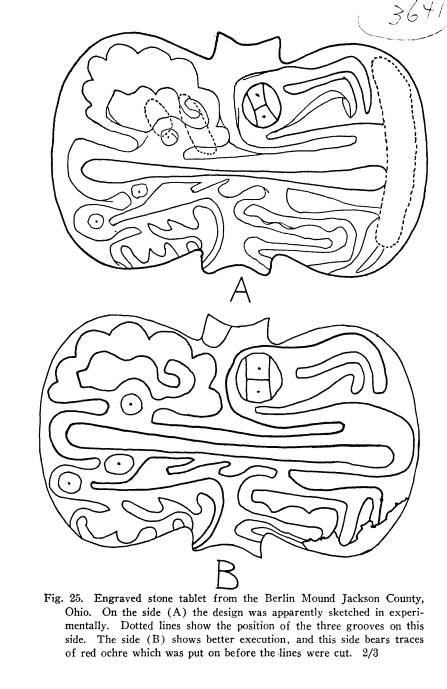
484
Ohio Arch. and Hist. Society Publications
pression about three-sixteenths of an
inch deep and one
and one-half inches in diameter,--a
variety no doubt of
the grooves found on the reverse sides
of the Cincinnati
and Wilmington Tablets. The design on
the Kiefer
Tablet is in relief of about one
thirty-second of an inch.
In June, 1876, the so-called Berlin
Tablet was found
in a mound in Lick township, Jackson
County, Ohio,
which is the same location as that
given for Mound 21
of the present report (See Berlin
Mound, Bibliography).
This tablet, in the Museum of the Ohio
State Archaeo-
ological and Historical Society, is
shown in Figure 25.
The same design, incised in narrow,
shallow lines with
no attempt at bas-relief, is found on
both sides, but the
execution is better on one side than on
the other. On
the latter side (Figure 25, A) there
are indentations or
grooves which were made before the
incised lines were
put on. The positions of these three
grooves are indi-
cated by dotted lines in the
illustration. The largest
one at the end is about one-eighth of
an inch in depth
and the others are shallower. On the opposite side
(Figure 25, B) there are unmistakable
traces of red
ochre. The material of the tablet is
fine-grained sand-
stone, gray in color. With it were
found an irregular
piece of the same material "having
on each side inden-
tations similar to those on the back of
the Cincinnati
Tablet" (page 74); also one piece
of graphite and two
arrow-points.
Another piece of "yellowish
sandstone" bearing an
incised design is reported by
Schoolcraft in Observa-
tions, Grave Creek Mound. This is also
reported in
Indian Tribes, Part First, Plate 29,
Figures 1, 2 and 3,
Coon Mound--Analysis of Adena
Culture 485
and on page 91, where it is said in
error to be the Cin-
cinnati Tablet. This specimen was taken
from one of
the minor mounds of the Grave Creek
Group in West
Virginia. When found, part of the
tablet had been
broken off. On one side the decorations
consist of six
concentric circles arranged in groups
of two, with trian-
gles, and squares obliquely placed and
incised parallel
lines and ellipses on the other side.
The dimensions are
not given.
A tabulation of the foregoing discloses
the following
information: Five sandstone tablets
engraved with fun-
damentally similar designs were found
in one mound in
West Virginia and in four in Ohio, all
of them contain-
ing traits of Adena culture. All of the
tablets are rec-
tangular, and all have grooves on one
side. Two of
these mounds contained skeletons in
wheel-shaped for-
mation around a central clay knob, and
if the spots on
the tablet from Mound 26 are correctly
interpreted as
red ochre, three of the mounds exhibit
the use of red
ochre on artifacts. One of these
engraved tablets, and
skeletons in wheel-shaped formation,
were found in
Mounds 26 and 57, both belonging to the
Adena culture.
In addition the Wilmington Mound and
Mound 26 ex-
hibit Trait 14, the Berlin Mound Traits
49 and 58, and
the Kiefer Mound Traits 3, 40 and 49,
Mound 57 shows
Trait 40 in common with the Kiefer
Mound, and Traits
1 and 34 in common with Mound 26,
besides having the
wheel-shaped arrangement of skeletons
in common with
the Wilmington and Kiefer Mounds.
Despite the fact
that one engraved tablet was found in
only one of the
70 mounds, it is apparent that this
type of artifact will
486 Ohio Arch. and Hist. Society Publications
be found in Adena type mounds to be
excavated in the
future. The occurrence of engraved
tablets in two
mounds which also have skeletons in
wheel-shaped for-
mation, indicates the possibility that
we are here deal-
ing with a specialized branch or
variety of the Adena
culture.
In three of the 70 mounds there were
found peculiar
constructions of clay, described in
Table C as "Vaults,
beehive type," which seem to have
been used for burial.
One of these was found in Mound 57,
near the central
skeleton around which the other ten
were arranged in
wheel-shaped formation. This vault was
conical, about
four feet high and five feet in
diameter. It was filled
with "rotten wood, bark, human and
other bones * * *".
Of Mound 61, Thomas says that
"previous to building
the mound, a pit * * * had been dug to
the depth of four
feet in the original soil, and on the
floor of this pit at
one side, arranged in a semi-circle,
had been formed six
small clay vaults in the shape of
beehives; they were
about 3 feet in diameter at the bottom
and the same in
height and made of mixed clay and
ashes, very hard and
impervious to water." Fragments of
bones were found
in some of them. Of Mound 64, Thomas
has the fol-
lowing to say: "Excavations in the
natural earth re-
vealed a circle, 12 feet in diameter,
of vaults about 3 feet
broad and the same in height, similar
to those mentioned,
placed very close together and filled
with mud." In
Problem of the Ohio Mounds, the same
authority says
on page 48 that vaults like these have
been found in
South Carolina and in Tennessee.
Coon Mound--Analysis of Adena
Culture 487
CONCLUSION
Comparison of Adena and Hopewell. In his de-
scription of Mound 12, Mills commits
himself to the
belief that the Adena culture precedes
the Hopewell in
time. With less conviction Shetrone
mentions this as a
possibility in Culture Problem in Ohio,
page 161. The
supposition that Adena is older than
Hopewell rests
upon the assumption that these two
cultures are related
at all. It is not strange however that a
connection be-
tween the two should be sought for,
since both types oc-
cur in Ohio in close proximity and have
many features
in common whose occurrence is limited,
or which are en-
tirely lacking, in other cultures of
the mound area.
There are three ways of looking at the
Hopewell-
Adena problem. The relationship may be
chronological,
wherein the Adena is regarded as an
early stage of the
Hopewell; the relationship may be
sociological, wherein
the Adena traits may be interpreted as
those of a special-
ized cult or caste existing within and
contemporaneous
to the Hopewell culture as we know it
by the examina-
tion of burial mounds; or the
relationship may be more
apparent than real.
In an attempt to show that the Hopewell
grew out
of the Adena it is necessary to bring
forth elements of
the latter culture which are not
susceptible to the socio-
logical explanation, that is, to
explanation as the result
of political or religious distinctions
existant within the
Hopewell culture. This probably cannot
be done. But
there is at least one element of Adena
culture which is
strongly suggestive of a developmental
process with its
end-point in the Hopewell, namely, the
relative size of
488
Ohio Arch. and Hist. Society Publications
the log tomb considered in connection
with the propor-
tions between cremation and inhumation.
The average
size of the log tomb in the Adena group
is much greater
than in the Hopewell, and only nine
percent of Adena
burials are cremated, whereas in the
Hopewell 77 percent
are cremated (See Explorations of the
Seip Group, page
504). Since one or more uncremated
bodies require a
larger tomb than an equal number of cremations,
a
gradual restriction in the size of the
log tomb during a
development from Adena to Hopewell may
have accom-
panied an increasing use of cremation.
The copper breastplate might be
regarded as the final
form of an evolutionary sequence begun
in the Adena.
This type of artifact, very common in
Hopewell mounds,
may be a derivative of the stone
gorget, of which 64 were
found in 32 of the 70 Adena type
mounds. An inter-
mediary form between the two is the small
rectangular
copper gorget with two holes and
serrated edges from
Mound 44. The Adena type of sub-floor
burial might
also be interpreted as a chronological
feature, suggest-
ing an elaboration of the simple,
sub-surface grave with
no earth piled above the surface.
Sub-floor burial is one
of the major features of the Adena
culture, occuring in
18 of the 70 mounds herein listed,
whereas it is very
rare in mounds of the Hopewell type.
This implication
of precedence in time for sub-floor
mound burial is dis-
cussed at length by the writer in
Origin and Develop-
ment. It is important in this
connection to note that the
only timbered sepulchre found in a
mound of the Hope-
well type comparable to those of the
Adena, Coon and
other mounds, namely the structure enclosing
the Mul-
Coon Mound--Analysis of Adena
Culture 489
tiple Burial in Seip Mound Number 1,
was on the floor
of the mound at the original level of
the ground (See
Explorations of the Seip Group, page
369 et. seq.).
Other features indicating the
chronological prece-
dence of the Adena are the use of
copper almost exclu-
sively for ornamental purposes, and the
occurrence of
crematory basins, handles, bracelets,
platform pipes and
other forms in both types of mound.
Mound 34 pre-
sents features which may represent a
transition, con-
taining a number of cremated burials
and two crematory
basins. Another mound of a transitional
type is the Mc-
Kenzie Mound in Pike County, Ohio,
which was one of
a group of three and contained a copper
bracelet, ear-
spools, and leaf-shaped blades with
triangular notches
(See Field Work, Moorehead, Volume VII,
pages 156-
159 and Figure XXII). Two platform
pipes, made of
steatite, were found in Mounds 54 and
59. Minor dif-
ferences in proportion and material
used, and the em-
bellishment of the bowl with effigies,
constitute the only
changes in this type of artifact from
Adena to Hope-
well. The handles of the Hopewell type
are generally
smaller than those found in Adena
mounds, and always
show a copper stain in the hole, like
the two from Mound
54. Finally, there is a similarity
between the conven-
tionalized designs on the stone tablets
of the type found
in Mound 26, listed in Table C, and the
open-work de-
signs on copper plates from mounds of
the Hopewell
type. Willoughby has shown the close
resemblance be-
tween the Cincinnati Tablet (from Mound
26), and a
design in sheet-copper from the
Hopewell Group (The
Hopewell Mound Group, pages 126-127,
Figure 19, a
490
Ohio Arch. and Hist. Society Publications
and b). This represents a change in
material as well as
an apparent evolution in design in the
direction of con-
ventionalization.
In support of the sociological
explanation the follow-
ing considerations are mentioned.
As against the diminution in size of
the log tomb
from Adena to Hopewell as a result of
the increase in
the practice of cremation, attention
may again be called
to the Multiple Burial in Seip Mound
Number 1. This
was enclosed in a log tomb measuring 12
by 15 feet.
There were six uncremated burials
accompanied by ar-
tifacts which suggested an unusual
importance for the
individuals represented. If this
conclusion is correct,
the cremated burials in this mound
represent individuals
of less importance, a state of affairs
pointing to a con-
siderable importance for the uncremated
burials in
mounds of the Adena type. This
supposition is sup-
ported by the frequent occurrence of only
a single indi-
vidual in the 70 Adena type mounds, as
for example in
Mound 43. Some light is thrown on the
social status
during life of individuals whose
remains are found cre-
mated, by an analysis of certain
features of Mound 25
of the Hopewell Group (See Explorations
of the Hope-
well Group, pages 57-101). In this
mound there were
34 inhumations and 21 cremations. There
were arti-
facts with all inhumations, and an
unusually large num-
ber with some of them. Only 13 of the
cremations were
accompanied by artifacts, and in every
instance there
were only a few. Of four burials,
numbered 27, 30, 31
and 32 in that report, all cremated and
without artifacts,
the graves were poorly prepared. In
view of the fre-
Coon Mound--Analysis of Adena
Culture 491
quence with which copper bracelets are
found with im-
portant central inhumations of the type
found in Mound
43, it is significant that in this
Mound 25 of the Hope-
well Group, four copper bracelets
accompanied Burial
Number 7 which, with its companion
burial, also a skel-
eton, was "richly supplied with
artifacts and in several
exhibited features was probably unique
in Ohio mound
exploration" (page 63).
The use of copper exclusively for
ornament lends
itself as easily to a sociological as
to a chronological
significance. In Seip Mound Number 1
(page 400)
only 12 percent of the copper objects
were of the prac-
tical type. This discrimination may
well be the result
of a preference for the so-called
ornamental forms for
use as tributes to the dead; in fact
they, and even the
practical forms like the celt, may have
been made ex-
pressly for that purpose.
In Culture Problem in Ohio (page 161),
Shetrone
says that if the Adena should prove
antecedent to the
Hopewell "we must suppose a very
considerable period
of time necessary for the Adena people
so completely to
change their distinctive traits, and to
evolve into the
typical Hopewell culture variety."
Evidence pointing to
a gradual change in artifact-forms from
Adena to
Hopewell has already been discussed.
Against this evi-
dence is the scarcity of definite
stages in a developmental
series, and the great length of the
intervals which sepa-
rate the few that exist. In the
Hopewell new forms are
presented suddenly and fully-developed,
like the ear-
spool, the clay platform underlying the
log tombs, the
gravel-covered primary mound, elaborate
mica designs,
492
Ohio Arch. and Hist. Society Publications
the use of obsidian, the great variety
of effigy and geo-
metrical forms in copper, the effigy
platform tobacco-
pipes and the geometrical inclosures.
Certain bones of 13 skeletons in ten of
the 70 mounds
of the Adena type were painted with red
ochre. The
significance of this custom among the
Choctaw with re-
gard to the social importance of the
individual whose
bones were painted with red ochre has
already been dis-
cussed under Conclusions in the
description of Mound
43.
The type of ceramic embellishment used
by the
Adena people is known only from the
five sherds from
Mound 53. These exhibit designs which
are identical
with those on the ceremonial vessels
from Hopewell
mounds.
Certain finds in other mounds of the
groups to Which
Mounds 53 and 70 belong, indicate a
precedence in time
for the Hopewell instead of the Adena.
Mound 53 was
one of a group of 15 mounds in Pike
County, Illinois.
In Mound 4 of this group, a tooth
identified as that of
the modern horse was found at a depth
of seven feet,
one and one-half feet above the floor
of the mound (See
(c) in Bibliography for Mound 53, page
24). Mound
70 was one of a group of three mounds
in Loudon
County, Tennessee. Thomas says of Mound
2 of this
group that two metal buckles were found
on a skeleton
lying at a depth of three and a half
feet below the top.
Apparently the buckles were of European
make, though
Thomas makes no direct statement to
that effect (Report
on the Mound Explorations, page 392).
Findings in a
mound with a number of Adena features,
in Marshall
Coon Mound--Analysis of Adena
Culture 493
County, Alabama, may be added
(Aboriginal Sites, I,
pages 290-297). The mound was conical,
50 feet in di-
ameter and nine and one-half feet high,
and contained 64
burials. With an extended skeleton in a
sub-floor grave
were found four copper bracelets and
discoidal shell
beads. With other burials there were
copper celts, H-
shaped gorgets of copper identical in
shape with the one
from Mound 59 described in Table B, copper
beads, dis-
codial and tubular, pieces of galena,
celts of shale and
shell gorgets. With one skeleton,
described as "well
within the body of the mound,"
were found a number of
beads made of the shell of Cyproea
moneta, the cowry
shell of Africa.
Nothing ascribable to the period after
1492 has been
found in a mound of the Hopewell type,
nor in any
burial mound in Ohio.
Finally, to a large extent it is a
different numerical
predominance of the same or similar
traits which consti-
tutes the difference between Adena and
Hopewell. The
Adena culture, as it is presented in
this study, may be
said to be characterized by the first
12 traits in Table
A. All but one of the 70 mounds show
two or more of
Traits 1 to 12, each of which occurs
from 15 to 57 times
in the entire group. In individual
mounds each of these
traits is also represented a relatively
large number of
times. With the exception of Traits 5
and possibly 7,
these are all found to some extent in
mounds of the
Hopewell type.
Identity of the Adena people. Both the Adena and
the Hopewell show Cherokee and
Algonkian character-
istics. With regard to the former, the
idea that the Ohio
494
Ohio Arch. and Hist. Society Publications
mounds were built by the Cherokee is
not a new one.
Thomas (Problem of the Ohio Mounds)
sought to prove
forty years ago that "the
ancestors of the Cherokee
were the builders of some at least of
the typical works
of Ohio." He based his theory
largely upon a study of
the distribution and migrations of the
Cherokee, upon
the fact recorded by Adair that the
Cherokee were pro-
lific users of stone pipes resembling
(in Adair's de-
scriptions) the platform pipes of the
Hopewell type,
upon the presence of the
"beehive" type of vault in burial
mounds of the Kanawha Valley group in
West Virginia
(Mounds 57-69 of the present report),
and in Tennessee
and North Carolina; upon the similarity
of Mound 49
of the present report to mounds in
North Carolina, and
upon other criteria. Four years before
Thomas pub-
lished his Problem of the Ohio Mounds,
D. G. Brinton,
in Lenape and Their Legends, mentions a
Cherokee tra-
dition in which it was related that
they once lived, proba-
bly about the fourteenth century, in
the Ohio Valley,
and that they were the builders of
Grave Creek Mound
(Mound 55) and other earthworks in the
vicinity (page
17).
Recent excavations in Tennessee and
Georgia, the
general region occupied by the Cherokee
in historic
times, tend to support the above
claims. In Cherokee
and Earlier Remains, Harrington
describes three dis-
tinct culture-types which are, in the
order of what he
believes to be their appearance in the
region, the Round
Grave People, the Second People and the
Cherokee.
These three archaeological
culture-types are found to-
gether in the same mounds, village
sites and cemeteries
Coon Mound--Analysis of Adena
Culture 495
along the Upper Tennessee River, and
each of them ex-
hibit features of the Adena culture as
outlined in the
present study.
One of a group of three mounds at the
angles of a
triangle near Lenoir City (See page
34), a short dis-
tance north of Mound 70 of the present
report, in Lou-
don County, contained two sub-floor
graves. One of
these was near the center of the mound,
and a reference
to Figure 3 in Harrington's report will
show that the
material secured in excavating the
grave lies at its edge,
forming what is apparently a
symmetrical wall around
it, similar to that in Mound 43, the
Coon Mound. In the
other two mounds were found a square
copper gorget
with one hole and embossed edges (Plate
LXXXIII),
and an unperforated stone gorget. These
three mounds
are ascribed to the Cherokee (page 45).
Other artifacts
from them are described as typical for
the Cherokee
culture, but they are not found in
Adena type mounds;
small triangular points for example, of
which only one
was found in the 70 mounds, Mound 54.
There was
one cremation in these three mounds,
but most of the
inhumations were flexed.
In the rectangular graves at Mainland
Village Site
(page 47), ascribed to the Cherokee,
beads of Olivella
and Marginella shells, discoidal
shell beads, pearl beads.
perforated bear teeth, a hollow bone
spatula, a bone awl
and shell ear-pins were found, in
addition to the typical
triangular points. Skeletons were both
extended and
flexed. On Lenoir or Bussell's Island
(page 63) Har-
rington describes a mound examined by
the Bureau of
American Ethnology, which contained 14
skeletons with
496
Ohio Arch. and Hist. Society Publications
mica sheets, blue glass beads at the
neck of one skeleton
and iron bracelets with another. All
skeletons were ex-
tended. On the same site Harrington
found 32 of the
rectangular Cherokee graves,
accompanied by earthen-
ware water bottles and bowls, shell
beads, clay discs,
etc., and in graves of the historic
period, iron bracelets,
red paint, pearl beads and a circular
shell gorget. In
three mounds on Hiwassee Island (pages
96-127), one
of which was excavated by Clarence B.
Moore, the fol-
lowing Adena-like objects were found:
one elliptical
sandstone hone, 4.5 by 3.4 inches,
three slate gorgets,
two sandstone rasps, one
"smoothing stone," one celt
painted red, one bone awl painted red,
one small cup-like
concretion, one piece of graphite, one
stone disc, and
Olivella beads at the neck of a skeleton. The terms hone,
rasp and smoothing stone indicate
something of the na-
ture of the grooved stones listed in
Table A.
The Round Grave people buried their
tightly flexed
dead in circular pits, used vessels of
steatite, vessels of
clay with pointed bottoms and little
decoration, bone
awls, stemmed projectile points,
gorgets, and pendants
of animal incisors. In what is called
The Great Midden
(page 66) on Lenoir or Bussell's
Island, the lower por-
tion of which, according to Harrington,
was deposited
by the Round Grave people and the upper
by the Chero-
kee, a sandstone gorget with indented
sides, convex ends
and two perforations, identical in
outline with the one
listed in Table B as from Mound 36, was
found. It is
illustrated in Figure 21 of
Harrington's report. An-
other gorget, from a Round Grave on the
same site, is
described as of greenish banded slate,
oval in form, with
Coon Mound--Analysis of Adena
Culture 497
two holes. Still another, illustrated
by Harrington in
Figure 17, made of steatite, has convex
sides and
straight ends, resembling forms taken
from Adena type
mounds. The Round Grave artifacts and
burials were
found at Mainland Village Site, at
Lenoir or Bussell's
Island, and in a village layer which
underlay Mound 2
on Hiwassee Island, the same mound
heretofore men-
tioned.
The Second People are described by
Harrington as
the builders of most of the conical mounds
along the
Tennessee river between Lenoir City and
Hiwassee Is-
land (pages 278, 167). They practiced partial crema-
tion, used polychome pottery and
another form of a sim-
pler type, ornaments of marine shells,
triangular points,
and occasionally walled their graves
with stone. Har-
rington says on page 167 that the
artifacts of this Second
People resemble for the greater part
those of the Chero-
kee, and elsewhere, that it is possible
that they were the
ancestors of the Cherokee.
The relationship between these three
cultures may
be summed up as follows: Remains of the
Cherokee and
the Second People were found in the
three mounds near
Lenoir City, in Mound 5 on Hiwassee
Island, in the Na-
coochee Mound in Georgia and in one of
the mounds near
Rhea Springs. Harrington adds (page
144) that the gap
between the two "is bridged to a
certain extent by the
burials of the 'intermediate' period in
Mound 2, and
those of the highest level in Mound 5
(on Hiwassee Is-
land)". Remains of the Cherokee
and the Round
Grave People were found over a
contiguous area at
Mainland Village Site, in the Great
Midden on Lenoir
498
Ohio Arch. and Hist. Society Publications
or Bussell's Island, in Mound 2 on
Hiwassee Island
(artifacts only of the Round Grave
People were found
in a village layer beneath this mound).
Cherokee re-
mains only were found in one of the
mounds excavated
by the Bureau of American Ethnology on
Lenoir or
Bussell's Island, and in Mound E on
Hiwassee Island,
excavated by Moore. Harrington is
uncertain about
the identity of the builders of a
peripheral extension to
Mound 2, Hiwassee Island, saying on
page 111 that the
material found there "represents
either an early and un-
developed stage of the potter's art
among the Cherokee,
or the presence of a different but
unknown people, fol-
lowing not only the Round Grave period,
but the build-
ers of the original mound."
Of the Round Grave People, Harrington
says (page
167) that they were probably
"either Algonkians closely
related to those of the Middle Atlantic
slope, or had at
least been profoundly influenced by
them." He is in-
clined to identify the Second People
with the Cherokee.
The essential point in the foregoing
recount of Har-
rington's work in Tennessee is that so
many artifacts
and other features of the Adena type
are exhibited by
three different cultures (or two
cultures and one sub-
culture, that of the Second People)
which, despite the
difference between them are found in
association on the
same sites in Tennessee. Excavations by
Fowke in Vir-
ginia and eastern West Virginia reveal
a northward ex-
tension of this same Cherokee-Second
People complex.
The Linville mound in Rockingham
County, Virginia,
yielded red ochre, bone combs, cremated
burials, gorgets,
sub-floor burial chambers, Marginella and discoidal
Coon Mound--Analysis of Adena
Culture 499
shell beeds, steatite pipes, triangular
points, hematite
and bone needles (See Archeologic
Investigations, pages
37-44), and mounds in eastern West
Virginia contained
pitted stones, slate gorgets, mica
plates and triangular
points (See Archeologic Investigations,
pages 68-69).
Such features as these may well merge
imperceptibly
into the Adena of the Kanawha Valley.
Other similarities between the Cherokee
and the
Adena may be added. Harrington makes
the statement
(page 284) that "both the Overhill
Cherokee on Ten-
nessee river and the eastern Cherokee
at Nacooche used
* * * the celt type of axe exclusively,
and preferred the
leaf-shaped form of flint knife * *
*". The predominant
Cherokee triangular unnotched flint
point is of course,
with one exception, for Mound 54, not
found in mounds
of the Adena type. The reader will
recall Thomas'
opinion that the characters on the
inscribed stone from
Mound 70, in Tennessee, are those of
the Cherokee al-
phabet,--a fact however of questionable
value.
With regard to Cherokee features in
Hopewell
mounds in Ohio, it may be mentioned
that five large ef-
figy steatite pipes taken from Seip
Mound Number 1,
closely resemble forms found in
Tennessee (See Explo-
rations of the Seip Group, page 423),
and typical Cher-
okee potsherds identical in design with
those illustrated
in Plate LVII, c. d, f, Cherokee and
Earlier Remains,
were found in Seip Mound Number 2 (Explorations
of
the Seip Mound, Figure 39). Typical
Hopewell culture
traits are found at widely separated
points in the south
on sites which have not been attributed
definitely to any
historically known group. C. B. Moore
reports charac-
500 Ohio
Arch. and Hist. Society Publications
teristic ear-spools of clay, and of
copper-coated stone
and
shell from Moundville,
Alabama, Crittenden
County, Arkansas and Miller County,
Arkansas (See
respectively, Moundville Revisited,
page 346, Fig. 3;
Aboriginal Sites, II, page 430, Fig.
42; Aboriginal Sites,
III, page 547, Fig. 37). The site in
Miller County, Ar-
kansas, was a mound, and exhibited
several Hopewell
and Adena features, including shell
containers, pearl
beads, red ochre, grooved pieces of
sandstone, worked
sea-shell columellae, shell pins,
alligator teeth, a banner-
stone and earthenware pipes of a
modified platform
type. Typical Hopewell pottery is also
found in the
Gulf states, in a cemetery at
Moundville, Alabama (See
Aboriginal Remains, page 222, Figure
142), and in a
mound in Sharkey County, Mississippi
(See Certain
Mounds, page 587, Figure 3). At the
latter site two
complete pots were found, bearing on
their rims the
familiar cross hatch and punctate
pattern, and the body
of one is quadrilateral with rounded
corners. Finally,
the conjoined earthen square and circle
of the Hopewell
geometrical inclosures of Ohio find a
plausible explana-
tion in a game played by the Creek
Indians, described in
the following:
"The warriors have another
favourite game, called Chungke
* * *. They have near their state house, a square piece of
ground well cleaned, and fine sand is
carefully spread over it
* * *. Every square ground is supplemented with a circular
area having a single pole 25 to 30 feet
high in the middle * * *"
(Social Organization, Creek, pages
466-467).
Various authorities see similarities
between Algon-
kian and Hopewell. The Hopewell culinary
pottery
Coon Mound--Analysis of Adena
Culture 501
might well be classed as Algonkian (See
Explorations of
the Hopewell Group, page 126;
Explorations of the Seip
Group, page 436; Turner Group of
Earthworks, page
96). Hooton's study of the skeletal
remains from the
Turner Group of Earthworks revealed an
Algonkian
physical type (page 96), and the
occurrence of Algon-
kian artifacts in the immediate
vicinity of mounds ex-
hibiting Hopewell and Adena features in
Greene County,
Indiana, as described by Black in a
forthcoming report
of the Indiana Historical Bureau, must
be taken into
consideration. A possible connection
between Adena
and Algonkian has already been referred
to in the dis-
cussion of Mound 2 on Hiwassee Island
(Cherokee and
Earlier Remains, pages 96-127), which
was built on a
village layer ascribed to the Round
Grave people, tenta-
tively identified by Harrington as
Algonkian.
The problem of the identity of the
Adena people
thus becomes difficult of solution
because of the apparent
connection between Adena and Hopewell.
While the
bulk of the evidence for the Adena
points to the Chero-
kee, the Hopewell appears to contain
elements of Algon-
kian, Creek and Cherokee. It is
entirely possible that
the features by which all these culture
types resemble
one another are those of a purely
general nature, pos-
sessing nothing in themselves which
would limit them
to any one culture-group. Another
possibility is that
different culture-groups of a
continguous area practiced
mound-burial only for special
individuals, or upon oc-
casions of a special nature, and that
the artifacts buried
with these special dead were different
from those in
daily use. The Adena-Hopewell complex
may repre-
502
Ohio Arch. and Hist. Society Publications
sent such a condition with regard to
the Cherokee. It is
equally possible that the Adena type of
mound contains
the special burials of the Cherokee
only, while the Hope-
well mounds stand in the same relation
to some other
group. It is only in some such way as
this that the com-
plete absence of anything remotely
resembling a Hope-
well or Adena dwelling site can be
explained.
BIBLIOGRAPHY
KEY TO REFERENCES
A Concise History of Florida
A Concise History of East and West
Florida. B. Romans,
1775. Quoted in The Painting of Human
Bones Among the
Indians. Ales Hrdlicka, Smithsonian
Report, 1904, page 613.
AAOJ
The American Antiquarian and Oriental
Journal. Chicago:
Jameson & Morse, Publishers.
Aboriginal Sites
I. Aboriginal Sites on Tennessee
River. Clarence B. Moore.
Reprint from the Journal of the Academy
of Natural
Sciences of Philadelphia, Volume XVI.
Philadelphia, 1915.
II. Some Aboriginal Sites on
Mississippi River. Clarence B.
Moore. Reprinted from the Journal of the
Academy of
Natural Sciences of Philadelphia, Volume
XIII. Phila-
delphia, 1911.
III. Some Aboriginal Sites on Red
River. Clarence B.
Moore. Reprint from the Journal of the
Academy of Natural
Sciences of Philadelphia, Volume XIV.
Philadelphia, 1912.
Aboriginal Remains
Certain Aboriginal Remains of the
Black Warrior River.
Clarence B. Moore. Reprint from the Journal of the
Academy of Natural Sciences of
Philadelphia, Volume XIII.
Philadelphia, 1905.
American Pioneer
The American Pioneer. A monthly periodical devoted to
the objects of the Logan Historical
Society. Edited and
published by John S. Williams.
Cincinnati, Ohio. R. P.
Brooks, printer. Volume 2, May, 1843.
(503)
504 Ohio Arch. and Hist. Society Publications
Ancient Monuments
Ancient Monuments of the Mississippi
Valley. E. G. Squier
and E. H. Davis. Smithsonian
Contributions to Knowledge
New York and Cincinnati. MDCCCXLVIII.
Antiquities
Antiquities of Wisconsin. I.
A. Lapham. Smithsonian
Contributions to Knowledge. June, 1855.
Archeological History, New York
The Archeological History of New
York. A. C. Parker,
Part I, Nos. 235-236. Albany, N. Y.
July-August, 1920.
The University of New York, New York
State Museum.
Archeologic Investigations
Archeologic Investigations in James
and Potomac Valleys.
Gerard Fowke. Bulletin 23, Bureau of
American Ethnology.
Washington, 1895.
Archaeological History of Ohio
Archeological History of Ohio. Gerard Fowke. Columbus,
Ohio, 1902. Published by the Ohio State
Archaeological and
Historical Society. Press of Fred J.
Heer.
Archaeology of Ohio
Archeology of Ohio. M. C. Read. Western Reserve His-
torical Society, Tracts 73-84.
Cleveland, 1892. Volume III.
Burial Mounds
Burial Mounds of the Northern
Sections of the United
States. Cyrus Thomas. Fifth Annual Report, Bureau of
American Ethnology, 1883-'84.
Washington, 1887.
Certain Mounds
Certain Mounds of Arkansas and of
Mississippi. Reprint
from the Journal of the Academy of
Natural Sciences of
Philadelphia, Volume XIII. Philadelphia,
1908.
Cherokee and Earlier Remains
Cherokee and Earlier Remains on Upper
Tennessee River.
M. R. Harrington. Indian Notes and
Monographs. New
York, Museum of the American Indian,
Heye Foundation,
1922.
Coon Mound--Analysis of Adena
Culture 505
Culture Problem in Ohio
"The Culture Problem in Ohio
Archaeology." H. C. Shet-
rone. American Anthropologist, Volume
22, No.
1, January-
March, 1920. Pp. 144-172.
Explorations of the Hopewell Group
Explorations of the Hopewell Group of
Prehistoric Earth-
works. H. C. Shetrone. OAHS, Volume XXXV, 1926.
Pp. 5-227.
Explorations of the Seip Group
Explorations of the Seip Group of
Prehistoric Earthworths.
H. C. Shetrone and E. F. Greenman. OAHS,
Volume XL,
July, 1931. Pp. 349-509.
Explorations of the Seip Mound
Explorations of the Seip Mound. William C. Mills. OAHS,
Volume XVIII, 1909. Pp. 269-321.
Field Work, Moorehead
Report of Field Work. Warren K.
Moorehead. OAHS.
Indian Tribes
Indian Tribes. Henry R. Schoolcraft. Lippincott, Grambo
& Company. Philadelphia, 1851.
Lenape and Their Legends
The Lenape and Their Legends. D. G. Brinton. Phila
delpia, 1885.
Mound Builders, MacLean
The Mound Builders. J. P. MacLean. Robert Clarke &
Company, Cincinnati, 1879.
Mound Builders, Shetrone
The Mound Builders. Henry Clyde Shetrone. D. Appleton
& Company, New York, London.
MCMXXXI.
Moundville Revisited
Moundville Revisited. Clarence B. Moore, Reprint from the
Journal of the Academy of Natural
Sciences of Philadelphia,
Volume XIII. Philadelphia, 1907.
Observations, Grave Creek Mound
"Observations Respecting the Grave
Creek Mound." Henry
506 Ohio Arch. and Hist. Society Publications
R. Schoolcraft. Transactions of the
American Ethnological
Society, New York and London. MDCCCXLV. Pp. 369-
420.
OAHS
Publications of the Ohio
Archeological and Historical
Society.
Origin and Development
"Origin and Development of the
Burial Mound." E. F.
Greenman. American Anthropologist, Volume
34, Number
2, April-June, 1932. Pp. 286-295.
Prehistoric Ancestors
Our Prehistoric Ancestors. Herdman Fitzgerald Cleland.
Coward-McCann, Inc., New York. MCMXXVIII.
Primitive Man
Primitive Man in Ohio. Warren K. Moorehead. G. P. Put-
nam's Sons. New York, 1892.
Problem of the Ohio Mounds
The Problem of the Ohio Mounds. Cyrus Thomas. Smith-
sonian Institution, Bureau of Ethnology.
Government Print-
ing Office, Washington, 1889.
Proceedings, Davenport
Proceedings of the Davenport Academy
of Natural Sciences.
Published by the Academy.
Recent Mound Exploration
"Recent Mound Exploration in
Ohio." Gerard Fowke and
Warren K. Moorehead. Proceedings of
the Academy of
Natural Sciences of Philadelphia. 1894.
Records of the Past
Records of the Past. Editors, G. Frederick Wright, Fred-
erick Bennett Wright. Published by the
Records of the
Past Exploration Society, Washington, D.
C.
Report of Exploration
"Report of Exploration of Mounds in
Southeastern Ohio."
Annual Reports of the Peabody
Museum of American
Coon Mound--Analysis of Adena
Culture 507
Archeology and Ethnology. Volume II, 1876-'79. Cam-
bridge: 1880. E. B. Andrews. Pp. 48-74.
Report on the Mound Explorations
"Report on the Mound
Explorations." Cyrus Thomas.
Twelfth Annual Report, Bureau of
American Ethnology,
1890-'91. Government Printing Office,
Washington, 1894.
Social Organization, Creek
"Social Organization, and Usages of
the Indians of the
Creek Confederacy." John R.
Swanton. Forty-second An-
nual Report, Bureau of American
Ethnology.
Stone Ornaments
Stone Ornaments of the American
Indian. Warren K.
Moorehead. The Andover Press, Andover,
Mass., 1917.
The Hopewell Mound Group
"The Hopewell Mound Group of
Ohio." Warren K. Moore-
head. Field Museum of Natural
History, Anthropological
Series, Volume VI, No. 5. Chicago, 1922. Pp. 75-181.
Turner Group of Earthworks
The Turner Group of Earthworks,
Hamilton County, Ohio.
Charles C. Willoughby, with notes on the
skeletal remains
by Earnest A. Hooten. Papers of the
Peabody Museum of
American Archaeology and Ethnology,
Harvard University,
Volume VIII, No. 3. Cambridge,
Massachusetts, U. S. A.
Published by the Museum, 1922.
Note: Dr. Greenman has departed from the
usual rules in the
preparation of this bibliography for
what he believes to be a more prac-
tical form for the text of this
monograph. Ed.
MOUNDS 1 TO 70
OHIO
Mound I. The Adena
Mound, Chillicothe, Ross County. Diam-
eter 141 feet, height
26 feet.
33 burials.
Original
description Excavations of the Adena
Mound.
W. C. Mills. OAHS,
Volume X,
1902. Pp. 452-479.
Other references (a)
Excavation of the Adena Mound.
W. C. Mills. Records
of the Past.
Volume I, 1902. Pp. 131-149.
(b) Mound Builders, Shetrone. Pp. 167-
169.
(c) See original description of Mound 54,
pp. 161-163.
Mound 2. Six miles south
of Chillicothe, Ross County. Diam-
eter go feet, height
22 feet. I burial.
Original description Ancient Monuments. Pp.
162-163.
Other references (a) Burial
Mounds. Pp. 45-46.
(b) Archaeological History of Ohio. P.
359.
(c) Mound Builders, MacLean. Pp. 52-53.
Mound 3. Chillicothe,
Ross County. Diameter 80 feet, height
15 feet. 1 burial.
Original description Ancient Monuments. Pp.
164-165.
Other references (a) Archaeological
History of Ohio. P.
354.
Mound 4. Chillicothe,
Ross County. Diameter 40 feet, height
5 feet. I or more
burials.
Original description Ancient Monuments. Pp.
156-157.
Other references (a) Archaeological
History of Ohio. Pp.
353-354.
(508)
Coon
Mound--Analysis of Adena Culture 509
Mound 5. Chillicothe,
Ross County. Diameter 225 feet, height
35 feet. I burial.
Original
description Field Work,
Moorehead. Volume
VII, pp. 126-130.
Mound 6. Chillicothe,
Ross County. Diameter 200 feet, height
25 feet. I burial.
Original
description Field Work, Moorehead. Volume
VII, p. 132.
Mound 7. Chillicothe,
Ross County. Diameter 50 feet, height
8 feet. 15 burials.
Original
description Primitive Man. P. 148
(Mound 36).
Mound 8. Chillicothe,
Ross County. Diameter 70 feet, height
6 feet. 300 yards
from Mound 7. 2 burials.
Original
description Primitive Man. P. 155
(Mound 39).
Mound 9. Near Slate
Mills, Ross County. No dimensions given.
5 burials.
Original: description Primitive Man. P. 158 (Mound
45).
Other references (a) Archaeological
History of Ohio. Pp.
348-349.
Mound 10. One of a
conjoined group of four mounds, including
Mound II and the two mounds numbered 41 and 42 in Prim-
itive man, pp.
165-167. In Chillicothe, Ross County. Diam-
eter 65 feet, height
13 feet. I burial.
Original description Primitive Man. P. 162
(Mound 40).
Other references (a) Archaeological
History of Ohio. Pp.
354-355.
(b) Ancient Monuments. P. 171 and
Figure 57.
Mound II. One of a conjoined group of four mounds, including
Mound 10, and the two
mounds numbered 41 and 42 in Prim-
itive Man, pp.
165-167. In Chillicothe, Ross county. No di-
ameter given. Height
20 feet. 9 or more burials.
Original
description Primitive Man. P. 168
(Mound 43).
510 Ohio Arch. and Hist. Society
Publications
Other
references (a) Ancient Monuments. P. 171 and
Figure 57.
(b)
Archaeological History of Ohio. Pp.
355-357.
Mound 12. The
Westenhaver Mound. Wayne township, Pick-
away County.
Diameters 90 and 110 feet, height 16 feet. 15
burials.
Original
description Explorations of the
Westenhaver
Mound. W. C. Mills. OAHS,
Volume 26,
pp. 227-266.
Mound 13. The
Metzger Mound, Union township, Ross County.
Diameter 200 feet, height
34 feet. Excavated by Moorehead.
Original
description Recent Mound Exploration.
Pp. 314-
321.
Mound 14.
Concord township, Ross County. Diameter 60 feet,
height ii
feet. 6 burials.
Original
description Primitive
Man. P. 131 (Mound 17).
Mound 15.
Deercreek Mound. Deerfield township, Ross
County.
Diameter 115 feet, height 33 feet. 3 burials.
Original
description "The Deercreek
Mound." Walter A.
Dun. Journal of the Cincinnati
Society of
Natural History. Elm
Street
Printing Company. Volume
VII,
1884-'85. Pp. 194-203.
Mound 16. The
Overly Mound. Paxton township, Ross County.
Diameter 88
feet, height 18 feet. 8 burials.
Original
description Unpublished field notes of
W. C.
Mills. Excavated in July, 1911.
Material and
field notes in Museum,
Ohio State
Archaeological and His-
torical
Society.
Mound 17.
PeePee township, Pike County. Diameter 80 feet,
height 13
feet. 5 burials.
Coon Mound--Analysis of Adena
Culture 511
Original description "Mounds in Pike County, Ohio."
Gerard Fowke. American Arch-
ceologist. Columbus, Ohio. March
1898. Volume I, Part, 3. P. 62.
Other references (a)
Archaeological History of Ohio. Pp.
362-368.
(b) "Archaeological Investigations, II."
Gerard Fowke. Forty-fourth An-
nual Report, Bureau of American
Ethnology. 1926-1927. P. 501
(Mound 9).
Mound 18. Newton township, Pike County.
Diameter 75 feet,
height 10 feet. 11 burials.
Original description Recent Mound Exploration. Pp. 308-
311.
Other references (a) Archaeological History of Ohio. P.
376 (Mound 11). Excavated by
Fowke.
Mound 19. Pike County, three and
one-half miles south of Pike
ton. Diameters 130 and 110 feet,
height 18 feet. 3 burials.
Original description Archaeological History of Ohio. P.
377 (Mound 12).
Mound 20. Salt Creek Mound. Salt Creek
township, Hocking
County. Diameters 115 and 96 feet,
height 23 feet. 1 burial.
Original description Report on the Mound Explorations.
Pp. 446-449.
Other references (a)
Archaeological History of Ohio. Pp.
339-340.
Mound 21. The Wernke Mound. Lick township,
Jackson county.
Diameter 21 feet, height 3 feet and 8
inches. 2 burials.
Original description Archaeological Remains of Jackson
County.
W. C. Mills. OAHS,
Volume XXI, 1912. Pp. 210-212.
512 Ohio Arch. and Hist. Society
Publications
Other
references (a) Certain Mounds and Village Sites in
Ohio. W.
C. Mills. Reprinted
from OAHS. Columbus, Ohio,
1917. The F.
J. Heer Printing Co.
Volume 2, Part
2, p. 96.
Mound 22.
Jefferson township, Jackson County. Diameter 50
feet, height 6
feet. I or more burials.
Original
description The only published
account is in The
Ohio State
Journal, Columbus,
March 27,
1930, p. 1. Excavations
by Stephen
Richards, March, 1930.
Material and
manuscript report in
Museum, Ohio
State Archaeological
and Historical
Society.
Mound 23. New
Market township, Highland County. Diameter
50 feet,
height 9 feet. 1 or more burials.
Original
description No detailed account. Excavated in
August, 1896,
by M. A. Honline.
Material in
Museum, Ohio State
Archaeological,
and Historical So-
ciety.
Mound 24.
Clinton County, seven miles from Wilmington. Di-
ameter 110
feet, height 23 feet. 1 burial.
Original
description Primitive Man. P. 110
(Mound 82).
Mound 25.
Clinton County, three miles southwest of Wilming-
ton. Diameter
30 feet, height 21 feet. No burials men-
tioned.
Original
description Primitive
Man. P. 107 (Mound 77).
Other
references (a) Archaeological History of Ohio. P.
380.
Mound 26. The
Cincinnati Mound. Near corner of Fifth and
Mound Streets,
Cincinnati. Diameter 75 feet, height 25 feet.
2 burials.
Original
description American Pioneer. P. 195.
Coon
Mound--Analysis of Adena Culture 513
Other references (a) Archaeological
History of Ohio. P.
(b) 383.
Ancient Monuments. Pp.
274-276.
(c) Archaeology of Ohio. Pp. 101-104.
Discussion of the
Cincinnati Tablet.
(d) Mound Builders, MacLean. Pp. 105-
110.
(e) "Animal
Carvings from the Mounds
of the Mississippi
Valley." A. W.
Henshaw. Second
Annual Report
Bureau of
American Ethnology,
1880-'81. P. 117.
Discussion of
the Cincinnati Tablet.
(f) Indian Tribes,
Part 1. Plate 23, Fig-
ure 5. An illustration
of the Cin-
cinnati Tablet, said
in error on page
91 to have been
removed from one
of the mounds on Grave
Creek flats,
West Virginia.
(g) The Hopewell Mound
Group. P. 127,
Figure 19, a and b.
Mound 27. Anderson
township, Hamilton County. Diameters
200 and 325 feet,
height 45 feet. 6 or more burials.
Original
description Cincinnati Enquirer, October
9, 1927,
page 4, Sunday
Magazine Section.
W. L. Brilmayer.
Excavations by
Willis F. Walker, May,
1927. No
other published
account.
Mound 28. Ross
township, Butler County. Diameter 50 feet,
height 6 feet. 8 or
more burials.
Original
description Mound Builders, MacLean.
Pp. 192-
193.
Mound 29. One
of a group of seven mounds and an inclosure in
Jackson and German
townships, Montgomery County, with
Mounds 30, 31, 32.
Diameters 40 and 50 feet, height not
given. No burials.
514 Ohio Arch. and Hist. Society Publications
Original description The Ulrich Group of Mounds. Tru-
man B. Mills. OAHS, Volume 28,
1919. Pp. 162-175 (Mound No. 1).
Mound 30. One of a group of seven mounds
and an inclosure
in Jackson and German townships,
Montgomery County, with
Mounds 29, 31, 32. Diameters 40 and 50
feet. I burial.
Original description The Ulrich Group of Mounds. Tru-
man B. Mills. OAHS, Volume 28,
1919. Pp. 162-175 (Mound No. 2).
Mound 31. One of a group of seven mounds
and an inclosure
in Jackson and German townships,
Montgomery County, with
Mounds 29, 30, 32. Diameter 40 feet,
height not given. 2
burials.
Original description The Ulrich Group of Mounds. Tru-
man B. Mills. OAHS, Volume, 28,
1919. Pp. 162-175 (Mound No. 3).
Mound 32. One of a group of seven mounds
and an inclosure
in Jackson and German townships,
Montgomery County, with
Mounds 29, 30, 31. Diameters 45 and 83
feet, height 15 feet.
8 burials.
Original description The Ulrich Group of Mounds. Tru-
man B. Mills. OAHS, Volume 28,
1919.
Pp. 162-175 (The Fortney
Mound).
Mound 33. Monroe township, Preble
County. Diameters 45
and 65 feet, height 4 feet, 4 inches. 3
or more burials.
Original description The Lee Mound. H. R. McPherson.
Printed by the author, May, 1921.
Excavations by the author, Septem-
ber, 1920.
Mound 34. Jefferson township, Preble
County. Diameter 75
feet, height 4� feet. 12 or more
burials.
Mound 35. Near Greenlawn Bridge,
Columbus, Franklin County.
Diameter 90 feet, height 8 feet. 27
burials.
Coon Mound--Analysis of Adena
Culture 515
Original description "The Ambos Mound." Warren K.
Moorehead. Third Annual Report,
Ohio State Academy of Science,
PP. 7-9.
Mound 36. Columbus, Franklin County.
Dimensions and bur-
ials unknown.
Original description No published account. Material and
catalog information in Museum.
Ohio State Archaeological and His-
torical Society.
Mound 37. Columbus, Franklin County,
near Alum Creek. Di-
mensions and number of burials unknown.
Original description No published account. Material and
catalog information in Museum,
Ohio State Archaeological and His-
torical Society.
Mound 38. Mt. Vernon, Knox County.
Diameter 80 feet, height
11 feet. 1 burial.
Original description Report on the Mound Explorations.
Pp. 444-446.
Other references (a) Archaeological History of Ohio. Pp.
329-331.
Mound 39. Newark, Licking County.
Diameter 80 feet, height
10 feet. 14 or more burials.
Original description "Description of an Ancient Sepulch-
ral Mound near Newark, Ohio." O.
C. Marsh. The American Journal
of Sciences and Arts, Volume
XLII, July, 1866. Pp. 1-11.
Other references (a)
Archaeology of Ohio. Pp. 90-98.
(b) Archaeological History of Ohio. Pp.
333-335.
Mound 40. Licking Township, Licking
County. Dimensions not
given. 1 burial.
516 Ohio Arch. and Hist. Society
Publications
Original
description "Sketch of Ancient
Earthworks." I.
Dille. Smithsonian Report, 1866.
P. 360.
Other references (a) Mound
Builders, MacLean. P. 53.
(b) Burial Mounds. Pp. 46-47.
(c) Field Work, Moorehead. Volume V,
p. 173. 1897.
Mound 41. Hopewell township, Perry County. Diameter 120
feet, height 27 feet. 1 burial.
Original
description Field Work, Moorehead.
Volume VII,
pp. 138-140.
Other references (a)
History of Perry County. Clement L.
Martzolff. Columbus, 1902. Pp.
45-46.
Mound 42. Green
township, Hocking County. Diameter 80
feet, height 10 feet.
1 burial.
Original description Report of Exploration. P.
68.
Other references (a) Archaeological
History of Ohio. P.
339.
Mound 43. The Plains,
Athens township, Athens County. Di-
ameters 132 and 158
feet, height 30 feet. 1 burial.
Original
description Excavation of the Coon
Mound and
an Analysis of the
Adena Culture. E.
F. Greenman, OAHS,
Volume XLI,
No. 3. Pp. 366-523.
Other references (a)
Report of Exploration. Pp.
57-59
(The Beard Mound).
Mound 44: Athens
township, Athens County. Diameter 85 feet.
height 18 feet. 2 burials.
Original
description Report of Exploration. P.
71 (Wood-
ruff Connett's Large
Mound).
Other references (a)
"Notes on the Copper Objects from
North and South
America, con-
tained in the
Collections of the Pea-
Coon
Mound--Analysis of Adena Culture
517
body Museum."
F. W. Putnam.
Annual Reports of
the Peabody
Museum of American Archaeology
and Ethnology. Volume III, 1880-
'86. P. 105.
Discussion of the cop-
per band and serrated
copper gorget
from this mound.
(b) Archaeological
History of Ohio. Pp.
336-337.
Mound 45. Athens
township, Athens County. Diameter 40 feet,
height 6 feet. Number
of burials not given.
Original
description Report of
Exploration. Pp. 62-63
(Mound 4).
Mound 46. Athens
township, Athens County. Diameter 40
feet, height 6 feet.
1 burial.
Original description Report of Exploration. P.
59.
Other references (a) Burial
Mounds. Pp. 47-48.
(b) Archaeological History of Ohio. P.
336.
(c) Report on the Mound Exploration.
Pp. 678-679.
(d) Ancient Monuments. Pp. 64-65 and
Plate XXIII, Number 2.
Mound 47. Adams
township, Washington County. Dimensions
not given. No
burials.
Original description Primitive Man. P. 26.
Other references (a) Archaeological
History of Ohio. Pp.
338-339.
INDIANA
Mound 48. Mound Camp,
Brookeville township, Franklin
County. Diameter 83
feet, height 12 feet. 3 or more burials.
Original
description "The Archaeology of
the Whitewater
Valley." Frank
P. Setzler. Indiana
518 Ohio Arch. and Hist. Society Publications
History Bulletin, Volume VII, Sep-
tember, 1930. Number 12. Pp.
409, 467-481.
Mound 49. Franklin County. Diameter 60
feet, height 15 feet.
27 burials.
Original description "The
Glidwell Mound, Franklin
County, Indiana." G. W. Homsher.
Smithsonian Reports, 1882. Pp.
721-728, 732. Excavated in 1881.
Other references (a)
Problem of the Ohio Mounds. P. 50.
Mound 50. Rush County. Diameter 40 feet,
height 7 feet. 1
burial.
Original description "Mounds and Earthworks of Rush
County, Indiana." F. Jackman.
Smithsonian Reports, 1879. P. 376.
Mound 51. Morristown, Hanover township,
Shelby County. Di-
ameter 150 feet, height 7 feet. 3 burials.
Original description "The Kinsley Mound." F. W. Gott-
lieb. Proceedings of the Indiana
Academy of Science. Indianapolis,
Indiana. 1910. Pp. 159-161.
Mound 52. The Fudge Mound. Randolph
County. Diameter
100 feet, height 8 feet. 1 burial.
Original description "The Archaeology of Randolph County
and the Fudge Mound. Frank M.
Setzler." Indiana History
Bulletin,
Volume IX, No. 1, October, 1931.
Pp. 20, 27-37.
Other references (a)
Ancient Monuments. P. 93, Plate 33,
Number 2.
(b) Mound Builders, Shetrone. P. 248.
Coon Mound--Analysis of Adena
Culture 519
ILLINOIS
Mound 53. The McEvers Mound. Montezuma,
Pike County.
Diameter 130 feet, height 28 feet. 2 or more burials.
Original descriptions "Partial Excavation of the N. D. Mc-
Evers Mound." David I. Bushnell.
Records of the Past. Volume IV,
1905.
Pp. 202-205. Excavated in
1904.
The Montezuma Mounds. Gerard
Fowke. 1905. No publisher's or
printer's name.
Other references (a)
"The McEvers Mounds, Pike County.
Illinois." Clara
Kern Bayliss.
Records of the Past, Volume VI,
1907. Pp. 21-27 (Mound No. 1).
WEST VIRGINIA
Mound 54. Brooke County. Diameter 72
feet, height 13 feet.
I burial.
Original description "Excavation of an Indian Mound at
Beech Bottom, West Virginia."
Charles Bache and Linton Satterth-
waite, Jr. The Museum Journal,
Volume XXI, Nos. 3 and 4. Sep-
tember-December, 1930. Published
by the Museum of the University of
Pennsylvania. Philadelphia. Pp.
133-163.
Mound 55. Grave Creek Mound.
Moundsville, Marshall County.
Diameter 286 feet, height 69 feet. 3
burials.
Original description American Pioneer. Pp. 196-203. A
letter by A. B. Tomlinson, owner
and excavator, to J. S. Williams,
with editorial comments.
520 Ohio Arch. and Hist. Society
Publications
Other references (a)
Crania Americana. Samuel
George
Morton. Philadelphia
and London,
1839. P. 221. A letter from
James
W. Clemens.
(b) Burial Mounds. P.
51.
(c) Archaeological History of Ohio. Pp.
324-328.
(d) Observations, Grave Creek Mound.
Pp. 369-420.
(e) Grave Creek
Mound. E. O. Randall.
OAHS, Volume XVIII, 1909. P.
261.
(f) Archaeology of
Ohio. Pp. 106-109.
Discussion of the
Grave Creek Tab-
let.
(g) Indian Tribes,
Part First. Pp. 120-
124, Plate 28.
(h) Cleveland and Cuyahoga
County.
William R. Coates. Published by
the American
Historical Society.
Chicago, New York, 1924. Pp. 9-
11. Discussion of the Grave Creek
Tablet.
(i) "Frauds
and their Perpetrators." No
name. AAOJ, Volume
14, No. 1,
1892. P. 52. Discussion of the
Grave Creek Tablet.
(j) Travels Amongst American Indians.
Lindesay Brine.
London. Samp-
son Low, Marston
& Company.
1894. Pp. 57-61.
(k) Mound Builders,
MacLean. Pp. 91-
105.
(l) Prehistoric
Man. Daniel Wilson.
London: MacMillan and
Co., 1876.
Volume II, pp. 99-103. Discussion
of the Grave Creek
Tablet.
Coon Mound--Analysis of Adena
Cultnre 521
(m)
"Inscribed Stone of Grave
Creek
Mound." M. C. Read. AA0J,
Volume 1, April, 1878 to July, 1879.
Pp. 139-149.
PENNSYLVANIA
Mound 56. Monongahela. Diameter 60 feet,
height 9 feet. 8
burials.
Original description Report on the Mound Explorations.
P. 495.
WEST VIRGINIA
Kanawha Valley Group, 3 to 8 miles below
Charleston
Mound 57. Diameter 173 feet, height 33
feet. 14 burials
Original description Report on the Mound Explorations.
Pp. 415-417 (Mound 1).
Other references (a)
Burial Mounds. Pp. 53-54.
Mound 58. Diameters 35 and 40 feet,
height 4 feet. I burial.
Original description Report on the Mound Explorations.
Pp. 418-419 (Mound 11).
Other references (a)
Burial Mounds. Pp. 55-56.
Mound 59. Diameter 175 feet, height 35
feet. 8 burials.
Original description Report on the Mound Explorations.
Pp. 425-428 (Mound 21).
Other references (a) Burial Mounds. Pp. 51-53.
(b)
Archaeological History of Ohio. Pp.
328-329.
Mound 60. Diameter 100 feet, height 15
feet. 2 burials.
Original description Report on the Mound Explorations.
P. 428 (Mound 22).
Mound 61. Diameter 100 feet, height 25
feet. 7 burials.
Original description Report on the Mound Explorations.
Pp. 428-430 (Mound 23).
522 Ohio Arch. and Hist. Society
Publications
Other references (a) Burial
Mounds. Pp. 56-57.
(b) Archaeological History of Ohio. P.
329.
Mound 62. Diameter 95
feet, height 8 feet. 1 burial.
Original
description Report on the Mound
Explorations.
P. 431 (Mound 25).
Mound 63. Diameter 84
feet, height 6 feet. No burials.
Original
description Report on the Mound
Explorations.
P. 431 (Mound 27).
Mound 64. Diameter 95
feet, height 21 feet. 2 burials.
Original
description Report on the Mound
Explorations.
P. 431 (Mound 30).
Mound 65. Diameter
100 feet, height 25 feet. 4 burials.
Original
description Report on the Mound
Explorations.
P. 432 (Mound 31).
Mound 66. Diameter 50
feet, height 6 feet. 1 burial.
Original
description Report on the Mound
Explorations.
P. 413.
Mound 67. Diameter 20 feet, height 7
feet. 7 burials.
Original
description Burial Mounds. P. 55.
Mound 68. Diameter 20 feet, height 3
feet. 1 burial. 200 feet
from Mound 66.
Original
description Report on the Mound
Explorations.
P. 413.
Mound 69. Diameter 50
feet, height 5 feet. 4 or more burials.
Original
description Burial Mounds. P. 55.
TENNESSEE
Mound 70. Loudon
County, at entrance of Bat Creek into the
Little Tennessee
River. Diameter 28 feet, height 5 feet. 9
burials.
Original
description Report on the Mound
Explorations,
P. 392-393 (Mound 3).
Coon Mound--Analysis of Adena
Cultnre 523
OTHER MOUNDS
Berlin Mound. Lick township, Jackson
County, Ohio. Dimen-
sions not given. No burials found.
Excavated in 1876.
Original description "Description of an Engraved Stone
Found near Berlin, Jackson County,
Ohio." Jno. E. Sylvester. AAOJ,
Volume I, p. 73.
Kiefer Mound. Miami County, Ohio, at
Piqua. Diameter 120
feet, height not given. 17 burials.
Original description Blueprint by the excavator, J. A. Ray-
ner, Piqua, Ohio, in Museum, Ohio
State Archaeological and Historical
Society.
Other references (a)
Mound Builders, Shetrone. P.
93,
Figure 44.
(b)
Stone Ornaments, Figure 201A, and
Figure 187.
Nicholls Mound. Trempeleau County,
Wisconsin. Diameters
86 and 93 feet, height 11 feet. 7
burials.
Original description "A Wisconsin Variant of the Hope-
well Culture." W. C. McKern.
Bulletin of the Public Museum of
the City of Milwaukee. Volume
10, No. 2, June 10, 1931.
Pp. 243-
247.
Wilmington Mound. Clinton County, Ohio,
near Wilmington.
Diameters 40 and 45 feet, height 6 1/2
feet. Number of burials
not gven.
Original descriptions "A Description of Prehistoric Relics
found near Wilmington, Ohio." L.
B. Welch, J. M. Richardson.
AAOJ, Volume I, pp. 40-48.
An Illustrated Description of Prehis-
toric Relics found near Wilmington,
Ohio. L. B. Welch, J. M. Richard-
son. Journal Steam Print, Wil-
mington, 1879.

